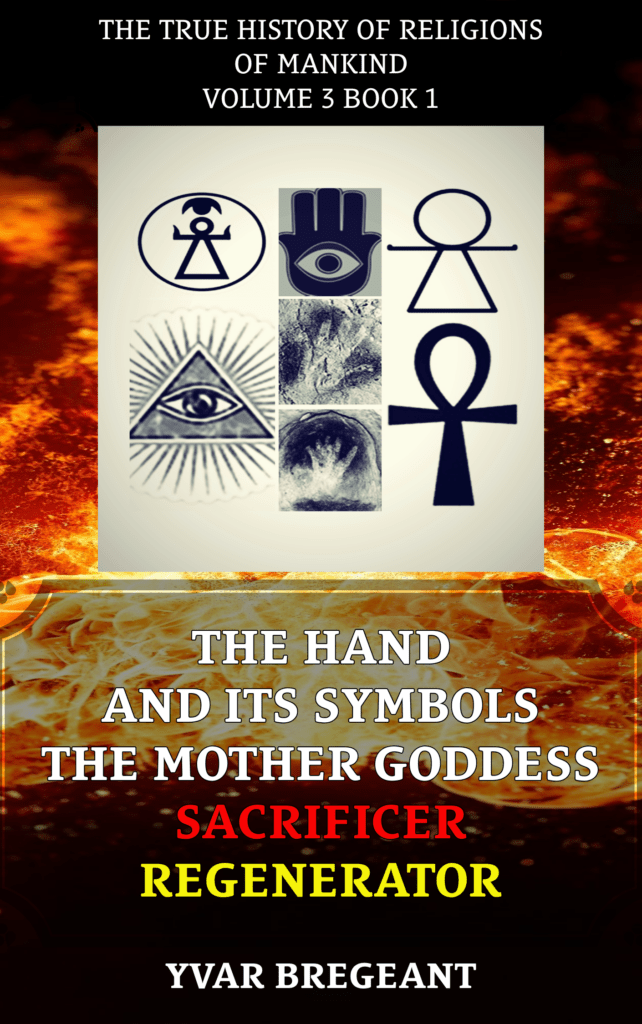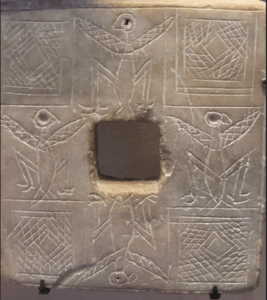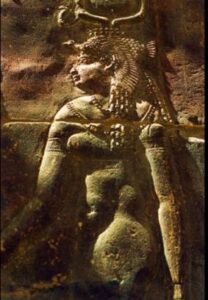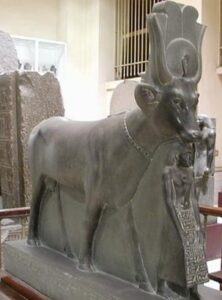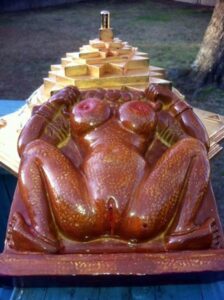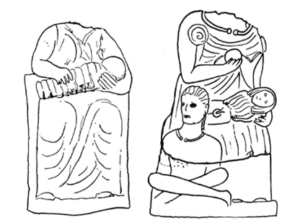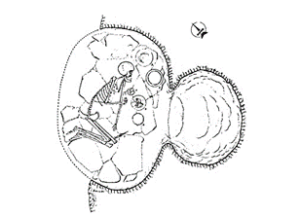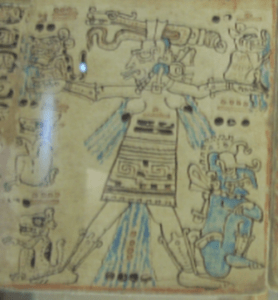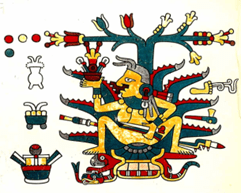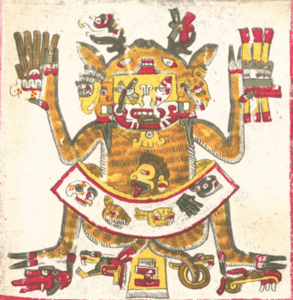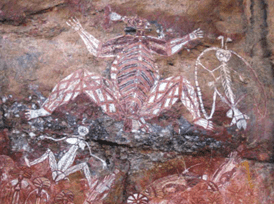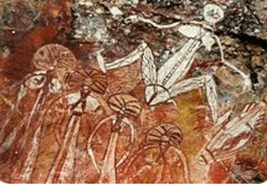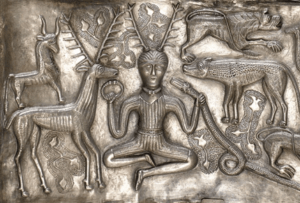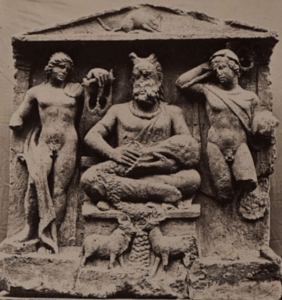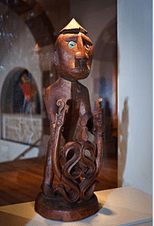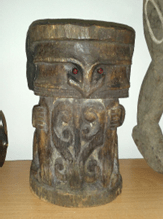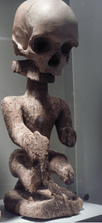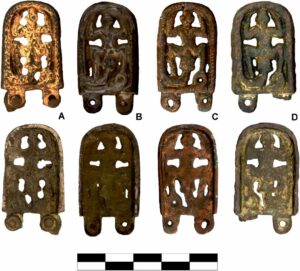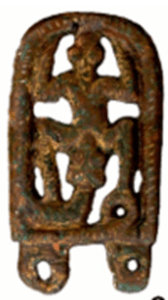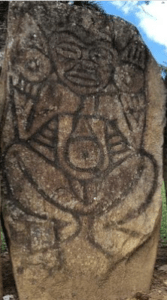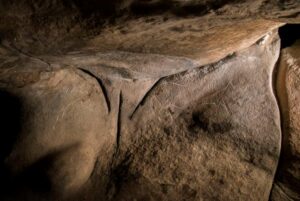PURPOSE OF THIS ARTICLE
This article will help you understand why the mother goddess and the great deities were depicted in a crouching position:
The link with the belief in their power to bring fertility to the world of the living and, above all, rebirth to the dead.
We’ll also look at the close link between this representation and the symbolic category of fluids.
Table of contents
LINK THIS ARTICLE TO THE ENTIRE LITERARY SERIES “THE TRUE HISTORY OF MANKIND’S RELIGIONS”.
This article is an excerpt from the following book entitled :
A book that you can also find here :
To find out why this book is part of the literary series The True History of Mankind’s Religions, go to :
Introduction / Structure and Content
I hope you enjoy reading this article, which is available in its entirety below.
THE SYMBOLISM OF THE CROUCHING MOTHER GODDESS
This symbolism is fully in line with the major teaching of the prehistoric mythological religion at the origin of paganism, which believed that the primordial human mother, who became Mother Goddess of the Earth, was able to regenerate and give new birth to all her devotees and worshippers. Indeed, the mother goddess was reputed to have regenerated and reborn her own husband after his death, enabling him to become a deity, the father of the gods (or even to remain on earth, incarnating himself in their son to continue guiding mankind).
This symbolism of the crouching goddess is thus one of the many major matrix symbols (places and objects) used by this religion to represent the matrix of the mother goddess, symbols which are/will be exhaustively listed and analyzed in volume 3 “The Bible of symbols of prehistoric and ancient mythological religion”.
This symbolism of the crouching goddess is also closely associated with the symbolism of fluids.
By way of reminder, as also explained and detailed in volume 2, it was taught that in her capacity as mother goddess capable of regenerating the father of the gods and giving life to the son-god, since the latter had the status of messiah, guide, but also redemptive power, she came to be seen as having the son-god’s own redemptive power, and thus as being able to give not only abundance and fertility on Earth, but also, and above all, immortality in the afterlife. It’s important to understand this, because it’s the key to understanding that this belief that the mother goddess herself could confer immortality through the fruit of her womb, her flesh coming out of her womb, is what explains the belief that the direct absorption of her vital fluids by her devotees (rather than passing through the redeeming son) could confer immortality.
Thus, on Earth, its vital fluids were synonymous not only with abundance and fertility, but also and above all with the elixirs of immortality.
Here again, volume 2 will provide an exhaustive list and analysis of the various symbols used in prehistoric mythological religion to represent, in all their mystique, the different bodily fluids coming from the body of the mother goddess (we can cite here, simply as an example, the symbolism of beer, which represents the urine of the great divinity[1] ).
It’s also very important to understand that this symbolism of the crouching goddess is very closely linked to the symbolism of the hand, for, although the symbolism of the hand is one of the most polysemous, it is one of its most important symbolisms. We’ll see this time and again, particularly when it comes to understanding the rationale behind the architecture and ornamentation of many temples. This link between the crouching goddess and the symbolism of the hand will not be dealt with in this article, but in a separate one to follow.
THE LINK BETWEEN CROUCHING AND (RE)BIRTH
The simple reason why the great deity has been depicted in the crouching position when regenerating or giving birth (whether to the great god or his worshippers), or when diffusing his fluids of earthly abundance or elixir of immortality, is because, in ancient times, the crouching position was the preferred position for giving birth.
It then became natural to represent the mother-goddess in this position, not only to give birth and give to the world the fruit of her womb, the son-messiah, but also to restore life to the dead and spread her vital fluids of abundance and immortality.
Let’s take a look at some examples that demonstrate this.
THE LINK BETWEEN CROUCHING AND CHILDBIRTH
First of all, let’s look at a few examples of how the crouching position was the position of childbirth.
IN EGYPT
For example, here’s what you can read about the Egyptian goddesses Hathor and Tawaret, deities of maternity and childbirth:
“The bas-reliefs of the temple in the ancient Egyptian Complex of Dendera depict a Woman giving birth in a crouching position and in the presence of the two birthing figures, the goddess Hathor and the goddess Taweret ; Hathor was an ancient popular deity with many associations, including those of Motherhood, Fertility and feminine love, which is why the ancient Egyptians believed that this deity should preside over all births as guardian of Women and Children, like Taweret, who was also a key goddess of Fertility and Childbirth, which may explain why there are no known words in ancient Egypt for midwife, obstetrician or gynecologist”.
“Women delivered their babies on their knees, crouching, or on a birthing seat as indicated in the hieroglyphs speaking of Birth, while hot water containing Honey was placed under the seat, so that the vapors would facilitate delivery, and incantations aiding delivery were repeated by the midwives such as those asking Amun to “make the heart of the deliverer, strong, in order to keep the unborn child alive.””
“The use of the crouching position or birthing seat was a very common method in ancient African traditions and today contemporary birthing traditions also advocate the use of the crouching position or birthing seat, for the simple reason that both encourage the use of gravity as a natural aid in this process.”
Note in passing that the goddess Amamët[2] and the goddess Maât[3] are also mentioned as crouching.
So far, nothing out of the ordinary.
It was just an obstetrical practice.
But if we turn to other descriptions of deities, we’ll see that this representation goes far beyond the simple descriptive framework of a human giving birth, aided by goddesses.
As we’ve just seen in Egypt, major deities are represented in this way.
Let’s turn now to other civilizations and their imagery of local deities.
THE LINK BETWEEN CROUCHING AND REBIRTH
IN ELAM
Allow me first to introduce this structure, an Elamite perforated plate found in the Louvre.
Musée du Louvre. Text from the Louvre: Perforated plate. Four eagles with outstretched wings; squared squares. Alabaster. Susa. Sukkalmah dynasty (mid-20th century-1500 BC). Source photo : Yvar Bregeant
As you can see, it’s square-shaped, with four eagles (actually vultures) crouching with wings spread on either side of a central square-shaped hole, with a striated square between each vulture.
To understand the symbolism of this plaque, you need to know the respective symbolism of the square, the perforated stone, the broken column, the pyramid, the mountain and the vulture.
If you know the meaning of each of these symbols, you’ll understand the significance of their union here.
To cut a long story short, the square here represents the mountain, which is a symbol of the mother goddess’s body.
Note that the four striated squares represent, as seen from above in perspective, pyramids with tiers rising towards the sky to indicate elevation towards the heavens. Remember then that the pyramid is strictly associated with the mountain and is also a symbol of the body of the mother goddess.
In this respect, let’s just remember that the word for mountain is šadu in Akkadian[4] , one of whose meanings is, literally, in Sumerian, ša[5] the body, the womb of the[6] that gives or restores life.
Nota Bene:
This rebirth is essentially conveyed by the homonym “dú”, equivalent to tud or tu, which means: to bear, to give birth to, to engender, to be born, to make, to shape, to create; to be born again, transformed, changed. With dú, it’s not only a question of birth, of being shaped, but also of rebirth, of transformation into a new being, an operation reputed to take place by returning to the ša, the body or womb of the mother goddess.
The perforated stone represents the broken column of primordial man, whose restoration within the pyramid represents his regeneration as father of the gods.
The vulture is one of the major representations of the mother goddess in her role as presiding over the process of rebirth after death.
Now, since we’re sticking to the symbolism of the crouching goddess, what do we notice here?
That the body of the crouching vulture goddess is a symbol directly associated with that of the pyramid, whose primary purpose is regeneration, the rebirth of the primordial father as father of the gods.
Two of the vultures even seem to lay their eggs directly in the two pyramids below her.
So there’s a close link between crouching and rebirth.
IN CRETE
Equally remarkable is the fact that in Crete, as with Hathor in Egypt, “the Great Mother Goddess, probably Rhea[7] , is depicted, depending on the period, either crouching or standing[8] “.
IN GREECE
The meaning of this crouching representation of the mother goddess can also be found in Greece.
Indeed, it should be noted that the Greek goddesses of birth or childbirth, the illythies, daughters of Hera (the name of the Greek mother-goddess), are also depicted in the crouching position, a position recognized as being conducive to childbirth. Given that Illythie can also be understood as a duplicate of Hera, we understand that the mother-goddess was also represented in a crouching position as the mother-goddess of birth and childbirth[9] .
It is therefore particularly interesting to look at the Sumerian etymology of illythia[10] .
As we shall see almost systematically, the Sumerian language underpins the entire mystical edifice of mythological religion.
De facto, it becomes abundantly clear why they were given the name Illythia.
SUMERIAN ETYMOLOGY OF ILLYTHIA
Let’s break it down into Sumerian: íli-ti-a :
ETYMOLOGY OF íli :
íl-lá[11] means an elevation and in its verbal form íla, íli, íl[12] means to lift, carry, deliver, bring, endure, endure, “…”; to be elevated; to shine; lal, lá (la2)[13] means to be elevated; to hold, elevate, carry, suspend
So, by íli, we’re not just talking about carrying in the sense of conceiving as a genitor, but also carrying, elevating (to exalt, as it were) in the sense of deifying!
In this respect, it is important to mention here that these various Sumerian logograms (íl-lá; verb form íla, íli , íl; lal, lá (la2)) are recognized as the origin of the names of the gods “Īl” and “Ēl” and are the constituent root of the Sumerian word ĪLU, which has, among other meanings, that of “god”[14] .
So it’s imperative to understand two things:
Equivalence between childbearing and definition
The first is that this Greek “illy” means “to raise, to carry” with the double meaning of :
- Not only to carry in her womb to give birth
- But also, and above all, to elevate, to take to heaven, to make it shine… in other words, to deify the object of the (re)birth in question.
Just as aka “the door” has this double meaning
It’s interesting to note that íli has the double meaning of to carry in the sense of to carry in one’s belly and to carry to the skies, as does the Sumerian aka4 which designates the frame or lintel of a door.
Indeed, just as in French we say “la porte” (from the Latin porta, “door of a city, of a monument”, which supplanted the words fores and janua), but also “porter” (from the Latin portare) in the sense of carrying a child and also in the sense of “to carry, raise, elevate”, so it is exactly the same in Sumerian.
Indeed, if aka4 in Sumerian means a doorframe or lintel[15] , its homophone a-ka has the equivalent úgu[16] whose homophone úgu4 (KU) means to bear produce procreate[17] .
Moreover, ka and ga are strictly equivalent homophones in Sumerian, and with ga6 or gùr, the Sumerian lexicon indicates that these two phonemes mean to carry, to transport, while specifying that this is the reading made by the Sumerian city of Umma for the sign íla[18] .
However, as we have just seen, íl-lá and the verb forms íla, íli, íl carry the idea of elevation in the sense of deification.
Thus, we can say that just as in French the word porte (door lintel) (aka4) also carries (!) the meaning of bearing a child, of engendering (by a-ka / ugu) it also carries by the association ka / ga with íl-lá that of exalting, of elevating in the sense of deifying!
Or, to put it another way, in Sumerian there’s a semantic chain: door – a woman who carries or procreates – to carry in the sense of elevating to the rank of divinity.
Link between “íli” “a-ka” and the first name “Eve
We’ve also seen from the analysis of Eve’s name and the symbolism of the door that aka was one of her Sumerian names as the mother of her offspring (hence the fact that the door and doorpost were one of her major emblems).
In itself, this association of ideas between íli and a-ka to designate both the fact of bearing a child and elevation to the rank of divinity can only confirm our belief that the birth provided by the Greek goddess Hera-illyria is in fact a power to allow the rebirth of a being and confer divinity on it.
And this association also lifts a part of the veil that conceals the real face of the primordial woman behind the veil of the mother-goddess Hera: Eve.
“Ili” also means to shine, to hold, to carry.
If we now return to the meaning of íli, you may also have noticed in passing that to be elevated is synonymous with to shine, to hold, to carry…
Perhaps you’ll understand better then why, at the moment of birth, as mentioned in the note on Hera quoted above, Hera-Illythia was also depicted holding a torch, symbolizing, of course, light, but also, as we shall see, the symbolism of the star of the born-again being, now a star, symbolizing the attainment of divinity.
This is further proof that sacred Greek has its roots in Sumerian.
íli” refers to the deification of the primordial father, the ancestor of humanity.
The second thing to understand about the meaning of the Greek illy, a transliteration of the Sumerian íli , is that this elevation refers to the elevation of primordial man, a human being, to the rank of god.
Why is that?
A god doesn’t need to BE ELEVATED or DEIFIED. He ALREADY is.
Because quite simply, the fact that a god needs to be elevated, carried, held, suspended, implies that this has not always been his condition. A true god doesn’t need to be elevated, to be put on high, because he already is and always has been.
This action of elevation thus indicates by name and literally the mythification (not to say mystification) that consisted in making mankind believe that the primordial man, after his death, had become the great divinity, the father of the gods. Thanks to the regenerative power of his wife, now a mother-goddess, and the new birth she gave him by returning to her womb.
The equivalence between god and the father, the ancestor, the eldest, the oldest
Sumerian Īlu and illu
It could also be argued that this god was the primordial human for another reason.
It is indeed very interesting to note the meaning of Īlu mentioned by Mr Michel, for whom it has, among other meanings, that of “god[19] ” (the Sumerian name for god is usually diñir or dingir ).[20]
Indeed, its homophone illu means “high water, flood”; amniotic fluid[21]
Now, deluge is a synonym for father, because “a” means “father” and also “deluge”[22] .
What does this tell us?
That he who has been raised to the rank of divinity by the rebirth wrought by the mother-goddess, by the action of her carrying him in her womb and into heaven, is none other than the father, that is, her husband and spouse.
Elamite “nab” for god
Elamite confirmation that the god is the father can be found in the fact that the word for god is nab.
Indeed, this name means ocean, being the contraction of (ní “fear, respect” and “aba, ab” “lake, sea)[23] .
This symbolic ocean, lake and sea should not mislead us, for they actually refer to the Sumerian “a” for “father”, which means not only “flood”, but also “water” (see note above).
The Sumerian counterpart to the Elamite “nab”: father, elder, ancestor
Moreover, it is abundantly clear that this aba, ab elamite is the counterpart of Sumerian:
Indeed, in Sumerian aba, ab designates just as exactly “a lake, the sea”[24] , and its homophone ab-ba … the father, the eldest, the ancestor [25][26] .
Please understand, then, what this means: that he who, according to mythological religion, was carried in his womb by the mother goddess, to be granted a new birth after his death, a rebirth enabling him to be raised and become the father of the gods, is none other than the human ancestor, the eldest father, in other words, the primordial man.
Now that we’ve understood the meaning of íli to understand the meaning of the Greek illy in Hera’s name illythia, let’s turn to the meaning of ti.
This will allow us to completely lift the veil on the true identity of this mother goddess.
ETYMOLOGY OF “Ti”, “Te
As we’ve already seen in our analysis of Eve’s name and the symbolism of the rib, the vulture and the mortar, the primordial mother who gave life to humanity bore the Sumerian name Ti and its synonym Te.
Let’s briefly recall why:
“Ti”, the rib, the side, the spouse, the companion, the arrow
Because she was drawn from Adam’s rib or side, and because the word side in Sumerian means spouse or companion, Eve was called Ti or Te, and the symbols used to represent her included a rib or an arrow.
The reason for this is that in Sumerian “ te, ti ” are strictly synonymous[27] and that they indistinctly designate “a side, a rib, an arrow[28] ” .
“Ti”, life, the giver of life
Because she is the mother of all living beings and the one who gave life to her children, humanity.
Indeed, ti, like tìla, tìl and also means “life”.
tìla is a contraction of “tu“, “to be born” and “íla“, “to raise, to carry”, and therefore literally means “to raise, to carry the being born”.
This of course ties in perfectly with Eve, whose Hebrew name (with the yod which can be transliterated “y“, “v” or “w”) transliterates “haya” or “hava” or “hawa” and comes from a verb of root HWH carrying the idea of “to live” or “to make live” or “to make become” and therefore meaning “the mother of the living” or “she who gives life”.
“Te”, The foundation of the world
Because as woman and primordial mother she is at the foundation of the world (te)
“te” refers to the primordial female progenitor, the woman who founded the world of gods and men.
In fact, it’s quite remarkable that the cuneiform sign “te” transcribes the words “temen, te-me-en or te-me“, meaning “foundation” . [29]
So “te” means foundation, which of course logically applies to the primordial mother at the foundation of the world.
On this subject, for those who still doubt that sacred Sumerian is the origin of sacred Greek, for example, simply consider that if each of these terms designates a foundation, if we add to them the logogram suffix “eš” meaning “anointed” or “tomb”[30] , temen- eš then takes on the meaning of “temple” of “sanctuary”[31] , being literally the foundation or holy perimeter, which is obviously the real origin of the Greek word for sanctuary “temenos“[32] which designates more specifically the sacred space dedicated to the divinity[33] .
“Ti, Tum, aka”: She who does, acts
Further etymological evidence links the primordial mother Eve to the logograms “ti,” “te”.
The fact is that one of its major Sumerian names, aka, in its verbal form, has the meaning of doing, acting[34] .
Now, if te, ti are equivalent and mean, in particular, an arrow[35]
the logogram tum, which also signifies an arrow, also signifies an action, a work[36] .
On this axis too, the arrow (te, ti, tum) is a symbol of the primordial mother Eve-aka as the one who acts, who makes.
This fits in perfectly with the fact that the Hebrew name Eve is built on the verbal root HWH on which the name of the true god YHWH is also built, with the meaning of the one who makes (himself) become.
A brief reminder of why the primordial mother under “ti, te” was associated with the vulture and the mortar.
As a reminder, the Egyptian goddess Hathor was commonly depicted with a vulture and a mortar[37] .
The same was true of Isis, with whom she was associated.
Here’s an image of Isis wearing the attributes of Hathor on a bas-relief from the temple of Isis in Philæ, dating from the Ptolemaic period, and next to it on the right is a representation of Hathor in the Egyptian Museum in Cairo:
In the case of Isis-Hathor, the vulture on her head, the mortar above and the horns of the Hathor cow can be seen.
Why the vulture?
There are two clear and simple axes associating ti, te with the vulture, one of the emblematic symbols of the mother goddess.
“Te”, the bearded vulture
A first direct axis is the simple fact that “te” simply refers to a vulture[38] .
This is one of the major reasons why this animal has been used to represent Eve and all the senses attached to her from ti, te.
Te, a side by its equivalence with Á, á.
A second, more indirect axis is that Te le vautour also means a side, a word we know to be associated with the primordial woman.
We can say that vulture also means a rib, a side, a spouse, a companion because the Sumerian phonetic equivalent of “vulture” is “ Á[39] ” or “á“.
Now, one of the primary meanings of “á” is: a side, an arm[40] , words which, as demonstrated in detail in the symbolism of the rib[41], have the meaning of “companion, support, spouse”.
direct association with the Vulture in Egyptian hieroglyphs
By the way, since we’ve just said that the Sumerian vulture has the phonetic equivalent Á, this is fully corroborated by Egyptian hieroglyphics, where the A is represented by a vulture.
Indeed, what do Egyptian hieroglyphs tell us about this?
The “simple”, fundamental counterpart is as follows:
A = Vulture [42]
It’s the very first letter of the alphabet, when presented in phonemes.
Let’s face it, it’s quite extraordinary to see that while Sumerian names a vulture “te” with the corresponding ideographic value ” Á “, Egyptian names the vulture ideogram “A” in reverse!
Or, to visualize it better, when the Sumerian tells us:
“te” = “foundation, vulture, mortar”.
= á” = “side, arm
(= “ti” = “rib or side” / “life” / “arrow” …)
The Egyptian tells us: Vulture = “á”!
We could say that we’ve come full circle, and we can immediately discern the close link between archaic Sumer and Egypt, in terms of linguistics, i.e. the sacred linguistics that dictate mysticism and religion.
For it can surely be no coincidence that in Sumerian, as in Egyptian, the symbol of the vulture has a phonetic “a” as its correspondence or equivalence.
This simple example is already, in itself, indubitable proof that these two sacred languages are closely linked in their symbolic expression.
In this respect, we might add that if Champollion had known Sumerian, he wouldn’t have had to grope his way through deduction to work out the phonetic meaning of vulture.
But we’ll come back to this later, as this Sumerian-Hieroglyph correspondence, beyond its mere linguistic equivalence, has far-reaching implications on a sacred level, and therefore requires a dedicated chapter.
Conclusion on the meaning of “te” the rib, the side:
If we return to our demonstration that “te” does indeed designate a rib, a side, we have seen that this is indeed the case, and through two distinct semantic axes:
- By its equivalence with “ti” (rib, side, arrow)
- By its cuneiform sign “Á” “á” (arm, wing, rib, side, horn, power)
This cannot be a coincidence.
Why a mortar?
Let’s take a brief look at why the primordial mother (goddess) was associated with the mortar.
We’ll confine ourselves here to an etymological consideration, as there is also a powerful symbolic reason.
Let’s just say that vulture and mortar are synonyms in Sumerian.
Indeed, if in Sumerian “te” means “vulture”, its homophone “tè” also means “mortar or enclosure” (due to the equivalence of “tè” with “naña[43] “. Indeed, tè designates an alkaline plant, soapwort, cardamom, just as the term “naña” designates, in addition to soapwort, a mortar, an enclosure, a circle, the whole [44][45] ). This enclosure, this circle, itself refers to one of the meanings of te, which, as we have seen, designates a perimeter, a foundation.
Conclusion on the relationship between “ti, te” and the vulture and mortar
Thus, the primordial mother because she was called ti or te :
- Ti, the rib, the side (the spouse, the companion), the arrow
- Ti, life, the giver of life, the mother of all living beings like Eve under haya, hava, hawa
- Te, the foundation, the perimeter, the sacred enclosure
- Ti, tum, aka (Eve) she who does, acts
Was etymologically associated with the vulture because :
- Te is a vulture
- Te is a side, because a vulture is also pronounced Á and á means a side, an arm.
Etymologically associated with mortar because :
- Te la fondation le périmètre has as homophone “ tè ” which is equivalent to naña meaning a mortar and an enclosure, a circle, the totality.
We can thus see the following symbolic linkage, associated with Eve, the primordial mother turned mother-goddess, since etymologically intertwined between :
- ti = rib or side (spouse, partner), arrow; life
- te = foundation, perimeter, enclosure or circle; vulture
- tè = mortar, enclosure
- Á, á = side, arm (spouse, partner)
ETYMOLOGY OF A
Having seen the meanings of íli and ti, we now turn to the meaning of a.
We have already mentioned that Á, á can designate a side, an arm, in the sense of spouse, companion (cf. the symbolism of the rib).
We also saw a little earlier in the analysis of illu that a in Sumerian designates the father[46] .
As a result, the final a can just as easily refer to :
- the primordial mother as the rib, the side, the spouse, the companion of the father
- the father (with the possible double meaning of father, partner, companion)
CONCLUSION ON THE DEEPER MEANING OF ILLYTHIE
Thus, under the veil of the Greek Hera Illythia hides none other than the primordial mother Eve (haya, hava, hawa) under her Sumerian names of ti, te or aka :
- Ti, the rib, the side (the spouse, the companion), the arrow
- Ti, life, the giver of life, the mother of all living beings like Eve under haya, hava, hawa
- Te, the foundation, the perimeter, the sacred enclosure
- Ti, tum, aka (Eve) she who does, acts
With their associated symbols, the vulture (te: a vulture, one side Á and á) and the mortar (tè, naña, mortar and enclosure, circle, totality).
A mother with the power not only to give birth to her posterity, and to her children, but also and above all to give life by a new birth to her deceased husband and regenerate him into the great male divinity.
Further proof of the link between Eve sous ti, te and sacred (re)birth: the enclosure!
By the way, if you think that the birth she performs is a completely natural birth and has nothing mystical about it like the rebirth she brings to those who pass through her womb, then please consider this:
We’ve seen that the primordial mother-goddess, symbolized by the vulture and the mortar, is also a foundation, a sacred perimeter; this gave the name temen-eš[47] from the Sumerian temple to the name of the sanctuary of the Greek temple temenos “[48] a term that more specifically designates the sacred space dedicated to the divinity[49] .
We’ve also seen that te (as a homophone of “tè“, which is equivalent to naña) means not only a mortar, but also an enclosure, a circle (hence a circular enclosure) and “totality”.
Now, as it turns out, the term “pregnant” has an extraordinary double meaning, which is highly revealing of the mystique it conveys.
In hieroglyphic, a pregnant woman is called bkAt [50] and the enclosure, as the foundation and floor of a temple, is called bkyt or bAkAyt[51] .
These two terms are excessively close, if not equivalent, as Ay, A and y are potentially interchangeable in Egyptian[52] .
It’s quite extraordinary that, etymologically speaking, the foundation of a temple, its sacred enclosure, is synonymous with a pregnant woman![53]
Even if the whole symbolism of temples is obvious (a symbolism which is examined in detail in volume 3 The Bible of Symbols, as well as in volume 6 on megalithic and historical temples), this etymology alone, in this case Egyptian, is eminently revealing of the fact that in mythological mysticism, the temple was envisioned and conceived as the very symbol of the body of the mother-goddess, to represent by its circular foundation the power of her womb not only to bear children, but also to confer a new birth on the father of mankind to make him a deity and, by extension, on all his devout children.
We can also add that it is then considered to be the foundation not only of the material world, but also of the spiritual world. This is why te also means totality. It is the origin of the whole world, and it is the whole world.
We will, of course, have ample opportunity to develop these various considerations elsewhere.
I won’t go into the etymology of the Egyptian bkAt here. I will do so separately, but in view of what has been said here, this word is easily decomposable (ba-akA-t) and allows us to identify the primordial pregnant woman who generated this word.
What we absolutely must remember and understand in the logic of this article dedicated to the analysis of the crouching mother goddess is that, indisputably, the crouching position of the mother goddess under her many faces and names was not only intended to represent classical human birth, but also had an eminently important figurative and sacred symbolic purpose, in that it served to represent her power to procure the rebirth of the dead in the afterlife. Sacred symbolism that was, no pun intended, used at the foundation of the temples.
We also need to understand that, because the symbols chosen to represent her are strict synonyms of Eve’s name or of her various appellations, the veil of identity of this mother goddess has already been lifted in this simple article.
To attest to the universality and timelessness of this representation, let’s take a look at some other examples of crouching divinity :
THE MAYAS
Here are some simple examples of crouching Mayan deities:
Figure 3: Madrid Mayan Codex
Figure 4: Madrid Mayan Codex
LAJJA GAURI FROM THE INDUS VALLEY
It is remarkable that this representation of the crouching goddess is both emblematic and ancient in India.
Take the example of the goddess Lajja Gauri:
Devi bhakta – Personal work
Note in passing that these legs form an M, as we’ll see later.
According to the Rig Veda, one of the 4 great sacred books of Hinduism, she is the symbol of the mother goddess who gave birth to the universe, both spiritual and material.
“In the first age of deities, existence was born from non-existence,
The quarters of the firmament were born from Celle, who crouched with her legs spread.
The earth is born of She who crouched with her legs apart.
And from the earth, the quarters of the firmament were born.”
Rig Veda, 10.72.3-4
Thus, from the crouching mother goddess are supposed to come heaven and earth, the entire universe.
However, it is important to understand that the power attributed to him goes far beyond the “simple” creation of the world, including the world of the living.
For the mother goddess in this form is not only the creator of the world. She is also presented as the recreator of the world.
The title of the book from which this source is taken refers to this: “creative and regenerative”.
This is also what we’ll see below.
Note that this mother-goddess and her representation in this form date back to the earliest antiquity, since it is drawn from the cult of the great mother-goddess Shakti or Devi of the Indus Valley[54] , whose earliest traces are dated by archaeologists to be over 8,000 years old.
Remarkably, both of these names are direct names for Eve in Sumerian.
Shakti en sumérien
For example, shakti breaks down into ša-aka-ti in sacred Sumerian:
- (if, as we shall see in the analysis of primordial man, ša can designate him) ša[55] means (also) the body, the womb! the middle, the inside, the intestines, the heart, the stomach, the abdomen, the bowels, the riverbed, the body fluids, a hollow vessel containing water or grain or urine and excrement; and its homophones sag9, šag5, sig6, sa6, ša6 means divine grace, good fortune, fertility[56] .
- a-ka means procreative mother, genitrix (remember that a-ka has the equivalent úgu[57] whose homophone úgu4 (KU) means to bear, produce, procreate )[58]
- ti designates with ti: “the rib, the side (the spouse, the companion), the arrow”; with ti equivalent to tìla, tìl: “life, the giver of life, the mother of all the living” as Eve under haya, hava, hawa; and with ti equivalent to tum, aka, their meaning of “she who does, acts”).
Afterwards, you can always come and tell us that :
“Shakti represents the feminine element of every being and symbolizes the cosmic energy with which it identifies. Shakti is usually closely entwined with Çiva, who represents the Unmanifested, the Father, while she is the Manifestation, the divine Mother. Experienced Çiva transforms into Shakti. But she must remelt herself into him, to regain original unity. Çiva and Shakti are one in the Absolute, the two aspects, masculine and feminine, of unity”. (CHEVALIER-GHEEBRANT, Dictionnaire des Symboles, 2005, p. 881)…
… But this so-called “cosmic mother”, incarnation of the eternal feminine, will fool no-one, or rather only those unable to lift the veil of appearances behind which lies the primordial mother of humanity.
If anyone doubts the link between sacred Sumerian and Sanskrit, and that “aka” does not refer to the primordial mother Eve, let me simply remind you of this simple fact (among a myriad of other examples that I’ll have the opportunity to cite when analysing the name Eve):
AKKA IN SANSKRIT
Here is what is meant by different variations of the Sanskrit root AK[59] :
अ A, in the monosyll. ôṃ, represents viśṇu.
अ क् A K. akâmi –) means to go tortuously, to wind; to act in a tortuous manner. Gr. ἀγής, ἀγϰύλος (agês, agkulos).
अक AKA –) n. sin, fault; ‖ grief, sorrow.
अक्का AKKÂ –) f. mother.
Akkâ in Sanskrit therefore not only means Mother, but also has a very clear contemptuous consonance in direct etymological association with tortuous action (which the Sanskrit akâmi designates), with fault, sin and the resulting sorrow and grief (which its Sanskrit homophone aka designates).
You have to admit, it’s strange, to say the least, that these notions of sin, fault, tortuous action, sorrow and grief should be semantically associated with a “cosmic mother goddess” depicted as the source of all neutral and absolute energy…
On the other hand, it obviously corresponds perfectly to the life events of the primordial human mother.
Once again, this is just one fiber in a steady stream of evidence, all of which I shall endeavor to enumerate.
Concerning the Sanskrit akâmi, let us note, in addition, as if that were not enough, that mí ” in Sumerian designates a female[60] , a cavity, something or someone black, dark[61] , just like its synonym kúkku whose homophone designates an ancestor[62] …
Where, frankly, is the astonishment that, because of her tortuous actions, our ancestor, the primordial mother, was put to death and then deified and represented as a chtonian divinity, the goddess of the world of the dead and reigning from the cavern, her womb, over it?
Sha-aka-ti is thus, in both Sumerian and Sanskrit, a perfect avatar of the primordial mother Eve and of the divine power attributed to her to regenerate her husband through “ša”, her womb, and by extension, all the dead, to the point where she was elevated to the rank of goddess of heaven and earth, at the origin of the creation and re-creation of all things.
A GROUP OF THE MOTHER GODDESS AND THE “CROUCHING GOD” AT THE AUXERRE MUSEUM
In France, a very interesting statuary can be found at the Musée d’Auxerre (see illustration on right below).
Fig. 1 – Mother goddess of Capua.
Fig. 2 – Mother goddess of Auxerre. Reconstruction.
OBSERVATIONS
It associates three figures: the mother goddess in a dominant position, with an apple of immortality in her right hand, a child on her lap and left arm[63] and her parèdre crouching beside her.
The author of the article I referenced, Mr. Benoit Fernand, states that this mother goddess is a Courotroph goddess (i.e. a nurse), associated with Ceres-Demeter and, indeed, with all mother goddesses, whatever their names, and that she is a personification of Nature, of Mother Earth[64] .
I’d also like to draw your attention to the fact that she is depicted without a head, like the Maltese mother goddess we examined in the article on solving the mystery of the Maltese temples, and other mother goddesses we’ll be discussing in the future. Indeed, we’ll be taking an exhaustive look at why the mother goddess has been universally depicted without a head in Volume 2.
I would also draw your attention to the fact that his parèdre is associated with a horned god and is represented crouching, to his left, in a position of inferiority[65] and also asleep, eyes closed, a sleep that evokes the sleep of death[66] .
Also note in passing that the child is depicted swaddled and is sometimes interchanged with a boar[67] . I will explain separately the sacred meaning of the symbolism of bandages (which refers to the symbolism of the goddess of ropes or the one who ties), as well as the symbolism of the boar in separate, dedicated articles.
As for the child, note that unlike the mother goddess’s parèdre, who is “asleep in death”, he is, to say the least, very much alive, since he is represented in the ithyphallic position[68] (i.e. with erect sex).
After these few essential observations, the question is: what does this scene mean? And, in view of the article we’re dealing with here, why is the mother-goddess’s parèdre here in a crouching position?
WHAT DOES THIS SCENE MEAN?
WHAT PREVIOUS RESEARCHERS THINK:
According to Mr. Benoit Fernand, the author of the referenced article analyzing this statuary, the child serves to represent (as etruscologist and archaeologist Jacques Heurgon had already suggested) not classical maternity, birth, but the deceased[69] , who is welcomed, upon his death, into her womb, into the bosom of Mother Earth[70] .
What reinforces this idea is his observation that in the case of the Tourettes-sur-Loup statue, the mother-goddess is holding a severed head on her lap in place of the child, over which she is placing her left hand[71] . From this, he deduces that the severed head represents the dead, that it is the double of the deceased, and that this is also the meaning to be given to the child[72] .
As for the fact that this representation of the mother goddess is linked to the rebirth of the dead, he mentions the French scholars Camille Jullian and Salomon Reinach, whose findings are interesting, at least in demonstrating that this type of representation is indeed about the rebirth of the dead.
Indeed, Mr. Benoit Ferand rightly points out that the mother goddess is the goddess of the world of the living, but also of the dead, and that as “guardian of the sepulchre she is the one who communicates life” [73]
He goes on to report that Camille Julian (who shared the views of Salomon Reinach, a proponent of an animist or totemistic reading of mythology and religion), not only saw in it “the personification of ‘Mother Earth'”, but “was not afraid to assert that it was ‘supposed to re-engender the dead‘”: “hence”, he said, “the crouching position of skeletons”[74] .
THE TRUE MEANING OF THIS SCENE
To fully understand this scene, we need to put things into perspective and graduate the different levels of symbolism.
While it’s fair to say that the mother goddess depicted in this way serves to indicate that she is the mother goddess of the world of the dead and has the power to regenerate them, there are also many errors to be corrected.
The mother godess : the primordial mother, not a hypostasis
It is in fact false to say, as we systematically read from supporters of an animist or totemic or shamanic vision… that the mother goddess is merely a hypostasis of the Earth, i.e. a personification of the Earth made into a goddess by primitive populations (i.e. less cognitively endowed than us Westerners…).
Indeed, we’ll have ample opportunity to demonstrate – and this article will be just one of a thousand – that the sacred Sumerian and hieroglyphic languages on which the divine names and symbols of mythology are based, and which enable us to grasp their exact meaning, indisputably demonstrate that the mother goddess is, in fact, a very real character, no more and no less than the primordial human, Eve, who was deified mother-goddess of the Earth and the underworld. That she was quite simply the first of the gods, the deified ancestors! And that it was to her that the power to regenerate the dead was attributed.
Indeed, we shall see exhaustively that, not only has she been expressly and directly named under her various names under all the heavens, but that absolutely every event in her life is recounted in mythology (and the same goes for the primordial man, Adam…; for the events part, volume 2 will demonstrate this vividly).
What prevented all these eminent authors, like so many others, from seeing and understanding this was, it has to be said, among other things, their linguistic specialization, which in terms of ancient languages was often limited to Greek or Hebrew, which are in fact, from the point of view of linguistics and history, very recent languages and certainly not those on which all sacred symbolism is based. This lack of knowledge of the essential languages of Sumerian and Hieroglyphic necessarily led, by rebound, to their lack of understanding of symbolism, of the meaning of the symbols that are the keystone of mythological narratives. And without an understanding of this symbolic language, it’s impossible to access the very real story that myths tell, or the nature of the religion they preach.
But let’s return to the meaning of this representation:
A first-level reading: the triad
Above all, it’s absolutely essential to understand that the son in the mother-goddess’s arms is, before anything else, the reincarnation of his dead parèdre, husband, spouse, the very one crouching at his feet.
The first meaning of a child is not that it represents the deceased, in the sense of any deceased person.
For the deceased is first and foremost the father of the gods, his godfather.
And in this representation, the deceased is the crouching parèdre.
The child does not represent the deceased, the dead godfather, but what the godfather will be; it designates the regenerated godfather, when he returns from the world of the dead.
The message being: I am the almighty, and by the power of my womb, I can restore life to my husband and spouse, to the father of the gods who was put to death, and restore life to him in the form of our son whom he himself begat me before his death.
It’s no more and no less than the great classic triad we face : father, mother and son, reincarnation of the father.
The fact that the child is in the ithyphallic position serves to indicate not only that he is alive, but that he is the father, for, as we shall see, the father of the gods was regularly represented in the ithyphallic position to indicate not only his status as the father of humanity, but also, in his specific case, his ability to impregnate the mother and thereby give himself a new birth.
As for the fact that the child is sometimes substituted by a skull, this also serves to indicate that she has the power to restore life to the dead father of the gods. In all cases, whether child or skull, they both refer first and foremost to the father of the gods, either regenerated in the case of the child, or in the process of being regenerated in the case of the skull. In connection with the presence of a skull, it’s also very important to know and understand its symbolism, which is a microcosm of the cavern and points directly to the womb of the mother goddess, from which she brings forth, or reemerges, the world. This skull therefore goes far beyond the simple symbolism of a lambda deceased person.
A second-level reading: the message to worshippers
Secondly, it’s true that this representation also conveys a clear message to the pagan worshippers of this triad, no more and no less: a promise of immortality.
For what the father has experienced is a promise to his worshippers that they too will experience the same thing, provided they recognize the power of the mother goddess and worship her.
The message being: you see, just as the mother goddess matrix did for the father of the gods, it has the ability, the power, to regenerate you too when you die.
Hence the apple of immortality she hands them…
The same one she seized in her own time, believing in the same promise that had been made to her…
But this message, addressed to the worshippers who see the scene (to the “lambda deceased” one might say), it is important to understand, is a second-level meaning.
And in the case of worshippers, the child does not represent the deceased worshipper either, what he is, but again what he will be once he returns from the realm of the dead; he represents what the deceased may aspire to become, that is, he too, a born again, aspiring, like his ancestor, to divinity[75] .
THE REASON FOR THE CROUCHING OF THE FATHER OF THE GODS
As for the crouching, it’s fair to say that the crouching position of the father of the gods on the left and below the mother goddess symbolizes his dependence on her.
This scene clearly shows that the power of redemption and regeneration granted to the mother goddess helped give her a pre-eminent role. Even if, whatever supporters of the matriarchal cult may think, this in no way implies the absence of a patriarchal cult, as we shall see, since the two coexisted, feeding off each other. Benoit mentions, for example, the case of the crouching goddess of Besançon, who combines matriarchal attributes (crouching, cornucopia) and patriarchal ones (Cernunnos deer antlers).[76]
If we are to understand the meaning of the crouching position of the father of the gods, we need to place it in the overall context of this representation, whose central theme is, as we have seen, the teaching of rebirth of the dead through their return to the womb, the womb of the great goddess his wife.
Thus, crouching, whether when the mother goddess is crouching, or when the father of the gods is crouching, always has a connection with expressing the regeneration of being through the mother goddess’s womb and, as we’ll see later, a connection too with fluid symbolism.
In the case of the crouching father of the gods, two different meanings can be identified:
- When the father of the gods is depicted crouching in a dominant position, it’s to signify that, because he has succeeded in becoming a great divinity, he is just as likely, like the mother goddess, to communicate to the living and the dead, through the gift of his fluids or humours, abundance on earth and immortality in the afterlife. We’ll see this a little further on, with the example of Cernunos and the Mayan gods.
- When the father of the gods is represented in a weak position, as he is here, in a state of sleep symbolizing death, it’s to represent his foetal state. He is dead, and must go through a gestation process (which I’ll detail in a separate article) before he can claim rebirth.
This latter case is in line with the explanation given by Camille Jullian (referenced above) that the deceased were placed in the foetal position in the tombs to signify their rebirth to be provided for by the mother goddess.
Here’s an interesting example to follow :
THE PREHISTORIC SITE OF THARROS IN SARDINIA WITH A DECEASED PERSON CROUCHING IN THE FETAL POSITION, HOLDING A STATUETTE OF THE MOTHER GODDESS STEATOGYPE IN HIS HAND FACING THE FACE.
At the Tharros site in Sardinia, in one of the hypogeic tombs (i.e. an underground crypt or burial site), there is a “deceased person crouching in the foetal position, holding in his hand, pointing towards his face, a statuette of the Mother Goddess steatopyge[77] “.
But what nobody says – and apparently, nobody sees! – is that the tomb itself was designed to represent, if not the local mother goddess, at least her womb, into which the deceased was then placed.
Just look at this sketch of the archaeologist’s survey of this tomb:
Fig. 2 – Neolithic tomb at Cuccuru S’Arriu (second half of 4th millennium BC) (Archaeological Superintendence Archive)
The deceased was literally placed in the foetal position in a burial site that was also shaped like a womb!
This should come as no surprise to us, given the analysis of the megalithic temple at Göbekli Tepe, for example.
The underlying concept, of course, is that the deceased and the society that prepared him were absolutely convinced that his death was the prelude to his rebirth, thanks to the regenerative power attributed to the mother goddess’s womb.
A ÇATAL HÖYÜK
To attest to the age of this representation, we can also cite the following source:
“In Çatal Hüyük (Anatolia-Turkey) in the 1960s, archaeologist James Mellaart unearthed a number of statuettes. The female body is depicted in the birthing position, above bull skulls. For the archaeologist, these “sanctuaries” and statuettes reveal the existence of an original cult, paid to a divinity who created life and death. Founded on the concept of regeneration, this cult is said to have endured in Greek myths, making Anatolia the cradle of Western civilization. This discovery gave rise to the idea of a religion in which the female body embodied both the “Mother Goddess” and Mother Earth, and, more broadly, a divinity that created life and death[78] .
So, in a site as old as Çatal Hüyük in archaeological terms (dated between 7,100 and 5,600 BC), the mother goddess is again and again found in the birthing position, representing her power to bring life back to the dead.
The presence of a bull’s skull, one of the symbols of the father of the gods, indicates once again that the first object of this regeneration was her own husband.
THE SYMBOLISM OF THE GREAT CROUCHING DIVINITY AND THE SYMBOLISM OF VITAL FLUIDS
Having understood that the crouching position assumed by the mother-goddess represents her omnipotence over the world of the living and the dead, being a symbol of her status as mother-goddess not only of birth, but above all of the rebirth of the dead (with, foremost among them, her husband, the father of the gods reincarnated in the son-god), we will now take a brief look at another symbolism closely associated with the crouching position: that of vital fluids.
Let’s not forget that the symbolism of vital fluids expresses the mythological doctrine that all the vital fluids of the great divinity – urine, sweat, excrement, etc. – are the fruit of his body and flesh, just like his son, and are therefore true and perfect substitutes for this redeeming son-messiah.
Thus, in mythological paganism, mystically, drinking the urine of the great divinity, drinking his menstrual periods, feeding on his excrements, etc. was a ritual performed as a veritable Catholic transubstantiation supper, even if eminently pagan in nature, since in the minds of devotees it amounted to symbolically eating the flesh of the messiah son and thereby benefiting from his power of redemption synonymous with immortality.
Indeed, because the mother-goddess gave him life, and, as we shall see, because the father of the gods is also the progenitor of the promised pagan redemptive son-messiah, consuming the fruit of the flesh of the bodies of the great deities, whether mother or father, will be seen as a direct means, like elixirs of fertility and immortality, of obtaining abundance in earthly life and immortality, divinity in the afterlife.
Concerning the ability of the Father of the Gods to give his bodily fluids, which is an attribute generally associated with the Mother Goddess, it should be noted that the Mother Goddess is most often represented for two reasons:
Firstly, because it is of course a major player in the process of gestation and rebirth.
Secondly, by feeding on the fluids of the mother goddess, the worshiper symbolically feeds not only on the mother and son, but also on the father (since the son is the reincarnation of the father). In other words, the worshiper feeds on the whole triad.
However, as we shall see, it is also possible that the father of the gods, or even the son deity, is sometimes represented in isolation, standing or crouching, giving his fluids, since both may have been given the power to produce abundance and immortality, either directly or through a doctrinal shift.
If we now return to the representation of the crouching mother goddess giving birth and/or diffusing her fluids, here’s what A. Parks says in her book (which aims precisely in one of its notes to explain the hidden meaning of menstruation in ancient cults ):[79]
This is why an extraordinary number of figurines depicting the Mother Goddess, usually in a crouching posture, are regularly unearthed all over the world. As the moon influences the female menstrual cycle, it is, in this very particular respect, also a related symbol of the Mother Goddess. (A.PARKS, The Secret of the Dark Stars , 2005, pp. 201, 203).
This is also why the priestesses of the Mother Goddess were often sacred prostitutes, reputed to transmit the sacred vigor and royalty of the Mother Goddess to future kings and princes[80] .
He’s absolutely right.
The rite of drinking one’s menses, or more broadly, the fluids flowing from the body of the mother goddess, was undoubtedly a major sacred rite.
Let’s take a look at some Mayan examples that illustrate this very well:
THE MAYAS
Here is a figure from the Codex Borgia:
Figure 5: Codex Borgia
This figure has the advantage of being unambiguous.
Indeed, it’s obvious that the great deity is pregnant with this red circle on her belly.
There’s an association between her crouching position and childbirth, especially as she’s obviously reached full term.
With the crouching position, we’re still talking about childbirth, the culmination of the gestation process.
In addition to this basic understanding, we can add that fluid symbolism here is directly linked to the crouching position.
Why?
Just note that while the belly is shown in red, the scarf is also shown in red and runs straight down from the belly, ending with bangs.
Here’s another enlightening figure:
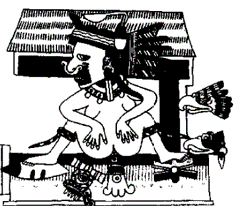
Figure 6: Borgia Mexican Codex, plate 74[81] .
You’ll notice, firstly, that the large deity is in a crouching position and, secondly, that a hand with an eye or circle inside (similar to an inverted Fatma hand) is in direct extension of the large deity’s spread legs, just like the fringed red scarf in the previous figure.
What is the purpose of this scarf or inverted hand coming from in direct association with the vagina of the divinity above, about to give birth or in the birthing position?
It is important to understand that this scarf with its bangs, or this hand when inverted, represents the fluids flowing from the mother goddess’ womb.
Why is this so?
Let’s turn to another illustration of a Mayan divinity, that of the Mayan mother goddess, Ixchel.
Figure 7: Madrid Maya Codex, plate 30 [82][83]
Ixchel, or Ix Chel, is the great Mayan mother goddess.
In glyphic texts, it is called “Chak Chel”.
Brief Sumerian etymology :
In Sumerian, Chak Chel can be broken down into ša-ak ša-el, i.e. the body, the womb, “ša“[84] from “ak(a)” the “procreator, genitrix”, which we know to be a name of Eve[85] and “ša” “el” the body, the womb of “a/el” the “raised father”.
You’ll notice that in this image from the codex, she has her arms and legs spread wide[86] and is spreading all her bodily fluids (milk from her breasts, sweat from her armpits, fluids from her vagina, but also her urine and excrement balls…).
You’ll tell me that in this imagery she’s not in a crouching position, but note: all the deities she’s associated with are.
It’s important to understand that, among the Maya, there’s a direct link between the crouching position of the great mother goddess, a divinity representing gestation and childbirth (which we know will lead to the birth of the son deity, reincarnation of the Father and endowed with redemptive power), and the symbolism of the fluids flowing from her body.
Here, too, are similar examples of large male and female deities associating the crouching position with the production of vital fluids such as elixirs.
Figure 1 image taken from the Mexican Codex Laud.
This figure depicts a horned God crouching in front of a turtle under a tree, emitting drops into a container.
Note that the Tortoise is right in front of the crouching deity, thus associating the Father of the gods with this attitude, but also the mother goddess since the Tortoise is one of her emblems[87] .
The other obvious association is the fact that the great deity is crouching as she collects fruit from her tree of life, which she then presses into an elixir of immortality.
So there’s an analogy between crouching and the production of immortality fluids.
But we also know that the tree is, among other things, a symbol of divinity itself[88] .
In other words, the tree from whose fruit the deity here extracts an elixir-like liquid of immortality is nothing other than his own body. It’s a way of saying that he has immortality inside him, and that he can extract it and give it to whomever he wishes.
Please also take a look at this other illustration:
Figure 2: Codex Borgia
Note that, with this other horned deity, the association between the crouching position and fluid collection can also be seen in this figure, with the small, cup-shaped altar between the legs of the great deity, clearly used to collect her bodily fluids.
What we have just said and seen, for example, helps us to understand the rock paintings of the Australian Aborigines:
Take, for example, the identical representations found in Aboriginal rock art:
Figure 8: Koala rock art Aboriginal rock art, Anbangbang rock shelter, Kakadu National Park, Australia
(According to ozoutback.com.au, it shows Namondjok, an ancestor of creation, with his wife Barrginj below, lightning man Namarrgon on the right and men and women in ceremonial headdresses below).
Figure 9: Petroglyph of the goddess Kunapipi, a traditional Aboriginal goddess from the Nourlangie Rock site in Kakadu, Australia, one of the oldest Aboriginal sites.
What are we seeing?
That the great god and the local mother goddess are both depicted in a crouching position!
What for? To give birth?
This cannot be the case with the Father of the gods
Here, they are factually both depicted in the birthing position, used to signify that as primordial father and mother and source of life and progenitors of the hero son-god with saving power, they bring life, fertility and immortality through the gift of their bodies and vital fluids to their worshippers by means of their local priesthood.
Here, too, it’s a ceremonial and sacred rite.
Let’s now look at other examples of how the father of the gods can be associated with the crouching position and/or the giving of vital fluids:
CELTIC WITH CERNUNNOS
The god Cernunnos (or Karnonos[89] ) is considered a true dis pater[90] .
We’ll have a chance to demonstrate that this is yet another face of the primordial, divinized human ancestor.
We can simply point out that he is represented as a stag god, since Cernunnos is depicted with a large stag antler and his Irish avatar, Nemed, is a stag god[91] ; that he is associated with Geyron, Trigaranus with their horned deity symbols, under the ox or bull.
Cernunnos on the Gundestrup cauldron Wikipedia at Cernunos
Goat horns, torque, ox, cornucopia and seated cross-legged posture of the Celtic god Cernunnos, Reims.
Some have thus associated him with Shiva, and deduce a probable mythological kinship between him and Shiva[92] .
What interests us in this article is that he is often depicted naked, cross-legged or in the lotus position[93] , while also frequently being directly associated with the mother goddess and holding a cornucopia[94] .
In our analysis of the horn of plenty, we have shown that this symbol, at the junction between the symbolism of the horn and the cup, the vase and the symbolism of the goat, is an eminently matrix symbol, representing the matrix in this case of the mother goddess.
So we understand why this god with a cornucopia is directly associated with the mother goddess.
Because this horn represents her womb. It represents her directly, as if she’s there, legs apart, in the birthing position, and the fact that he’s sitting cross-legged simply serves to recall the crouching position of the mother goddess when she gives life and when, mystically, she pours out her vital fluids from her womb onto the world, giving it abundance in the material world and immortality in the beyond.
It’s particularly interesting to note that this mother goddess, whose origins are obviously much older than Celtic, is a primordial goddess, ruling over the world of the living and the dead.
In fact, she is directly linked to Demeter, Cybele! and qualified as the goddess of the earth or Mother Earth.
Not only that, it is also linked to Neolithic female divinities[95] !
We’ll see that these observations only corroborate one of the facts demonstrated in my works, namely that all mother-goddesses are in truth mere multiplications of the same original divinity.
These simple observations, made by others than myself, help us to understand, at least a little, the universality and timelessness of the cult that was devoted to him.
I must add, of course, that my research will not only demonstrate this fact, but will go much further.
They will enable us to understand, at last! one absolutely essential thing: not only that all Mother Goddesses are variations or multiple faces of a single original Mother Goddess, but also, and above all, that Mother Goddess is not a mishmash concept of Mother Earth, an impersonal deity, a material Earth having been deified and made a person or character by humans a little less primitive than their fathers, who had begun to build spiritual concepts from natural observations (which is the scientistic postulate).
No, on the contrary, it’s about understanding that this original mother-goddess was, at the origin of the human world, a very real person, none other than the primordial mother of mankind, Eve. A primordial mother who was deified as, among other things, goddess of the earth and the underworld.
We need to understand that this is not an object made into a woman, but the opposite extreme, a woman made into an object, an object of adoration.
But let’s take a look at other examples of crouching deities associated with fluids:
IN OCEANIA WITH THE KORWAR
As another example of this representation of the deity in a crouching position, I invite you to take a look at the sacred statues from New Guinea called Korwar.
First of all, it is worth mentioning that, by the very admission of the natives who venerate them, they serve to materialize or represent the souls of the ancestors who reside there, the spirits who have been elevated to the rank of divinity[96] and who then remain on earth to continue to serve as guides for the living[97] .
This is, of course, yet another illustration of human mythology, which has consisted in divinizing ancestors, which necessarily implies, first and foremost, the primordial ancestor.
What’s interesting to note in the context of this article’s analysis is that he is shown in a crouched position, knees and elbows bent, with an openwork screen between his hands, which, depending on the observer, represents a tree of life or the snake’s moult, which are designated as symbols of rebirth.
Korwar at the Trop enmuseum & Korwar statuette from Papua (Indonesia), Cenderawasih region
Photo credit: Hiro-Heremoana – Own work
In addition, the korwar consists essentially of a skull because of its exaggerated shape compared to the rest of the body[98] .
Source photo : Clock – Personal work
An exceptional korwar is preserved in Paris (Musée du Louvre, Pavillon des Sessions): its head is not represented, but is made from a real human skull. He must have been a very powerful chief, hence the honor of having preserved his real head and not carved it.
This is symbolism:
- of the door or doorframe (the openwork screen) representing the entrance to the matrix of the mother goddess,
- or even to the symbolism of the cup, which has the same meaning,
- the W’s association with the serpent, itself associated with the original tree of life, and the proposal to feed on its fruits/fluids, symbols which both hold out the promise of rebirth after death, of immortality, for the worshippers of this ancestor-turned-deity, the same immortality that he is reputed to have attained, and who thus remains on earth to show the way to his own kind.
Remarkably, his crouching position is intimately linked to the contextual idea of rebirth expressed by all the figure’s related symbols.
We might add that the fact that he holds a frame in front of the living is an explicit invitation to enter the matrix and feed on the fruits of the tree of life, mystically represented by the vital fluids of the tree-mother goddess.
THE AVARS OF THE MIDDLE AGES (PRESENT-DAY CZECH REPUBLIC)
If we remain on the level of documentary fleshing out of this imagery of crouching goddess = diffusion of bodily fluids, and in order to understand now how absolutely timeless and universal this principle of esoteric religion is, we can further illustrate it with another example closer to home.
After that, we’ll move on to examples that go much further than anything we’ve expressed so far.
This example, closer to home, was the subject of a very recent article in Géo magazine, echoing an article published on the ScienceDirect website . [99]
It relates to the discovery of exceptionally well-preserved belt buckles from the early Middle Ages, bearing the “mysterious motif of a reptile and a frog”, found in several regions of Europe, and which observers believe suggest the existence of a medieval cult, hitherto unknown to historians, practiced by various populations, including the Avars.
Here’s what we’re told:
When it was discovered near the village of Lány (South Moravia, Czech Republic), archaeologists thought it was a unique decoration: a belt buckle from the early Middle Ages, bearing the fascinating motif of a “dragon” (or simply, a snake) devouring a frog. However, since its discovery twelve years ago, they have learned that other curious artifacts of this kind have been unearthed elsewhere in the country, as well as in Germany and Hungary.
A study was therefore carried out on these objects which, although identified hundreds of kilometers apart, show great similarity. The results, published in the Journal of Archaeological Science in January 2024 and reported by Masaryk University in Brno, highlight the existence of a hitherto unknown medieval pagan cult. It is thought to have been shared by various populations in Central Europe before the arrival of Christianity.
Fig. 1: Overview of the belt ends examined. A) Lány (CZ), B) Zsámbék (H), C) Iffelsdorf (GER), D) Nový Bydžov (CZ).
For the authors, it was a motif that “linked the various peoples on a spiritual level”.
The article goes on to say that the authors of the study cannot confirm what the image of these buckles, the “reptile” catching its prey, actually meant to those who wore them. They note, however, that pictures of confrontations involving a dragon or snake are common in pagan rites.
The battle scene was an ideogram representing an unknown, but clearly important, cosmogonic and fertility myth, well known to various early medieval populations of different origins, they write.
“The motif of a serpent or snake devouring its victim appears in Germanic, avaricious and Slavic mythology. It was a universally understandable and important ideogram,” explains Jiří Macháček, head of the Department of Archaeology and Museology at Masaryk University’s Faculty of Arts. “Today, we can only speculate about its exact meaning, but in the early Middle Ages, it connected the various peoples living in Central Europe on a spiritual level.”
Especially since the famous Slovakian Ore Mountains, from which the copper ore used to make the belt buckles came, were located… outside the heart of the Avar khaganate.
These mysterious objects thus reveal a dense network of communication – perhaps cult-motivated, the experts suggest – in the Carpathian basin and beyond. “The analysis […] confirms long-distance contacts between Avar and non-Avar elites across Central Europe.”
What’s extremely laughable from the point of view of the symbolism developed in these articles, when, as we have seen, it’s proven that the mother goddess poured her fluids over the world in her position of (re)generating the world, is the fact that this frog is presented as such, the serpent-dragon as well, and above all that this serpent would devour the frog.
However, there’s no question here of devouring the frog, which is one of the animal emblems of the mother goddess (cf. the symbolism of the frog, notably the Egyptian examples of Heqet, the god Noun and his goddess Nounet).
Just look at the picture:
I’ll enlarge it for you:
Image C) Iffelsdorf (GER) enlarged.
I’m sure you’ll agree that you’d have to be pretty blind not to see that this dragon-snake is strangely grabbing this frog in the universal crouching position by… its genitals.
Clearly, this representation is not about devouring in any way, but rather about the fact that the snake, which is a symbol of the great original evil deity, but also of rebirth and immortality, indicates the means to access them, namely by feeding on the vital fluids emerging from the womb of the mother goddess.
It’s a way of inviting his pagan worshippers to celebrate this rite in the following way: if you want to be immortal, here’s what you need to nourish yourself at the source, for there lies the source of all life at the origin of the world of the living and the dead.
In the light of everything we’ve already seen, we couldn’t be more explicit in illustrating this belief and the rite that accompanies it.
THE MOTHER GODDESS ATAGEY OF THE ARAWAK CULTURE IN AMAZONIA
To better understand this representation of the Avars, and as further proof of its universality, we can turn to the example of the Arawak mother goddess Atagey[100] :
Photo credits: @botanical.sorcery #storiadellarte #arthistory #histoiredelart #medievalart #petroglyphs #portorico #medievaltattoo #mittelalter #godess #anthropologie
Note in passing that she is depicted as an old woman with her eyes closed.
And, above all, as specified in the reference quoted (it’s not me who says it!) that its legs are similar to frog legs…
Having understood through these different examples (Mayas of South America, Aborigines of Australia, Celts of Western Europe, Melanesians of New Guinea, Avars of Central Europe, Arawaks of Mesoamerica) taken from different continents and different periods the universality and historical timelessness of this representation, belief and practice, let’s now turn to its roots in prehistoric times:
AN EXAMPLE FROM THE UPPER PALEOLITHIC: FONTAINEBLEAU (France)
Here’s what you can see and read about it in the article: Une ” Origine du monde ” préhistorique à Fontainebleau published in Le Monde on 26/10/2020 :
In a sandstone shelter, a hydraulic system was partly created by man and dates back to the Upper Paleolithic:
Here is the image in question:
The three deep cuts, partly man-made in the Upper Paleolithic, surrounded by two horses. EMILIE LESVIGNES
Between Nemours and Étampes” … “Many millennia ago, these sandstone chaotic features, rising out of a cold, treeless sea of sand, attracted our distant ancestors to another activity: engraving. Today, there are no fewer than 2,000 rock shelters in the area that bear the imprint of prehistoric humans inscribed in stone. Most of these engravings date from the Mesolithic period, 9,000 years ago, the work of the area’s last hunter-gatherers. All we see are geometric figures, alignments of lines, grids, more lines…
And yet, in the midst of this weary repetition, there is a much older figurative exception, left by the ancestors of these ancestors.
It’s a heavy block of sandstone at the heart of which are two thin, natural, parallel gutters. Immediately to the left of the entrance, the wall forms a small panel where two horses, one highly eroded, the other much more complete, frame an intriguing figure composed of just three deep cuts that evoke a woman’s pubis with a vulva in the center and can be translated into three typographical characters: \I/.
On the right-hand side of the panel, a natural crack in the rock has been enlarged to evoke a hip and upper thigh. On the left, the fork in the wall, which slopes towards the entrance, plays the same role. If you step back – which is difficult when you’re on all fours in a narrow gallery – you can see a kind of prehistoric, minimalist Origin of the World.
Chance and bad weather: there’s no way of knowing the age of the engraving by instrumental methods, but it’s not necessary, explains Boris Valentin, professor of prehistoric archaeology at the University of Paris-I: “In its disproportions and mode of treatment, the complete horse has all the stylistic characteristics of what can be seen in the Dordogne at Lascaux or in the engraved Gabillou cave”. The “Lascaux school”, to use Boris Valentin’s light-hearted expression, means the Upper Paleolithic and a representation dating back over twenty millennia.
“After heavy rain, I moved to the shelter. The ‘vulvar slit’ was running.”
This engraved panel has long been known, but the beauty of science is that it never ceases to re-examine its objects. The engraving was keeping a secret, and its discovery owes something to chance and bad weather, as geologist Médard Thiry, a former researcher at the École des Mines, who brought his intimate knowledge of Fontainebleau sandstone as a gift to the archaeologists, recounts: “On January 23, 2018, after the rains that had caused the Seine to flood, I went to the shelter. The ‘cleft vulva’ was flowing. It was really gripping and, from then on, I set out to understand whether this flow could also be induced on demand.”
But how? Médard Thiry had his own idea. He had noticed that, in the upper passage of the shelter, which runs parallel to the first, but higher up, some ten centimetres behind the engraved wall, there were two depressions in the rock. These were two natural basins where rainwater accumulated as it entered the gallery.
“We changed the geometry of one of these basins to deepen it, to free up and probably widen cracks in the rock below,” notes Médard Thiry. The geologist and a team of archaeologists meticulously analyzed even the tiniest fissures on the site, as well as the deep lines that make up the two sides of the “pubis”. These were clearly dug out by one or more human hands, and small traces of punching and removal still indicate that the rock was struck to widen the two lateral features. The aim? To lead water seeping into the porous sandstone towards the central slot.
To prove this, the researchers carried out the experiment themselves, described in a study published in the October issue of Journal of Archaeological Science: Reports. For a week, a simple reservoir and valve system supplied water to the basin, automatically maintaining a constant level as the liquid penetrated the rock. Water doesn’t travel through sandstone like that,” explains Médard Thiry. It has to wait until all the pores in the rock are saturated, and only then does it descend and concentrate on the lower part. In our experiment, we used around fifty liters of water and, after two and a half days, the vulvar fissure was flowing…”
Hydraulic engineering :
This is not the first time that prehistoric representations have been associated with water. In caves in the Quercy region, prehistoric art specialist Michel Lorblanchet has shown a number of cases where images are inscribed around underground resurgences, such as a fish from whose mouth a fountain flows in the Pergouset cave (Lot). In these examples, the decoration was organized around existing water,” emphasizes Médard Thiry. But there was no layout to direct the water to a specific place. We’re describing for the first time a sophisticated hydraulic layout in the Paleolithic period, one that makes a stage setting work.”
Lacking the prejudices of archaeologists, who hardly dare to propose interpretations of cave paintings, the geologist perceives in this device a representation of maternity. With the convex ceiling over the pubis, the woman would be pregnant, and the flow would represent the loss of water before childbirth. But is there only one woman? Aren’t we projecting a fantasy onto these slits?
For Boris Valentin, there’s really no room for doubt: “In the Paleolithic, there are a huge number of engraved, sculpted and painted representations of women and the female sex, for example in the Salle du Fond in the Chauvet cave. At Roc-aux-Sorciers, in the Vienne region of France, there are also three women – one of whom is clearly pregnant – of whom we can only see the belly, the pubis and the beginnings of the legs.”
In the Fontainebleau forest, it will be impossible to demonstrate with absolute certainty what use was made of this horse shelter, but, insists Boris Valentin, “the fact that we can force the flow, that the system can conduct water, is already an enormous piece of information in terms of the state of knowledge on the relationship between water and cave art”.
A BRIEF EXPLANATION OF FONTAINEBLEAU
I think that in the light of what has been said and demonstrated above, you now have a better idea of what this means.
I won’t even dwell here on the symbolism of the two horses[101]
What’s important is that the researchers mentioned in this article have perfectly understood that this representation is emblematic for its provoked, constructed character, and cannot be the result of chance, but rather, through the use of vaulting, sculpture and rock preparation, is part of an obvious desire to represent a pregnant woman whose womb is drained of water at the very moment of childbirth.
It’s easy to understand, in the light of what’s been said above, that it’s a question of representing the mother goddess of the rock as giving birth to the world, the living and the dead, for a new life, and consequently spreading her bodily fluids, her vital fluids, source of life and abundance in the world.
The very fact that the people present had to drink this water (or even perform ablution rites) bears witness to the fact that, in prehistoric thought, drinking water from this source was mystically equivalent to drinking the fluids flowing from the womb of the mother goddess.
It’s also interesting to note that this cult construction is located in the (scientistic) time line, by the very admission of the experts in question, not in the Neolithic (like the three sites of Göbekli Tepe, the megalithic temples of Malta and Stonehenge, which have already been analyzed), but in the Upper Paleolithic[102] ! (from the time of Lascaux, for example), i.e., from a scientistic point of view, well before the Neolithic.
It is therefore a cult practice which, in view of what has been developed above, covers the Upper Palaeolithic to the Middle Ages…
AN EXAMPLE FROM THE UPPER PALEOLITHIC: THE LAUSSEL VENUS
To further illustrate this concept of the association between the crouching goddess and fluids, and in line with the observation that there are numerous examples of statuettes of the mother goddess in the crouching position, here is an image that has been “scientifically” dated to the Gravetian period in the Upper Paleolithic, i.e. between -31,000 and 22,000 years ago:
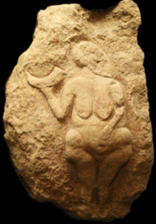
Venus de Laussel
Here’s what you can read about :
The Venus de Laussel or Horned Venus is a Paleolithic Venus dating from the Gravettian period (around 25,000 years ago).
Venus is depicted from the front. In her right hand, she holds a buffalo horn which, according to Waldemar Deonna (1913), could represent a cornucopia. On this horn are 13 notches; some researchers have suggested that they could represent the 13 annual lunar cycles or menstrual cycles.
Her left hand is resting on her belly, possibly indicating that she is pregnant. What appears to be her hair falls over her left shoulder. As with all Paleolithic Venuses, there are a number of figurative conventions, with some parts exaggeratedly developed, such as the abdomen, hips, breasts, buttocks and vulva, while others are absent, such as the feet and face, turned towards the horn.
https://fr.wikipedia.org/wiki/Vénus_de_Laussel
I can’t go into the symbolism of the cup and the cornucopia in particular (discussed in Volume 3), but it has been amply demonstrated that it is, especially in this context, one of the symbols of the mother goddess’s womb. The cornucopia is also directly linked to the symbolism of fluids, in that the mother goddess collects them in the same way as a cup and distributes them, bringing not only immortality to the deceased, but also abundance and material prosperity to the living.
What we need to understand when we see this image is the direct relationship between the crouching position, gestation and childbirth – something that everyone can observe, too – and secondly, something that’s only obvious through knowledge of the symbolism: the mother goddess’s bodily fluids, which are found in the cup of abundance she has harvested and which she will spread over the surrounding world of the living and the dead, two worlds over which she has dominion. Let’s understand that it could be her amniotic waters as well as her menses, but again, not only, but potentially all her bodily fluids, since as mother-goddess of life and mother of the redeeming son, mother-goddess of the Earth and the underworld, of the world of the dead, everything that emanates from her body is likely to procure abundance and life in the world, immortality and divinity in the afterlife.
INVITATION
Having understood the symbolism of the crouching mother-goddess as part of the teaching of rebirth from the dead, I now invite you to read the successive chapter or article entitled: a major symbolism of the hand: the crouching mother-goddess.
We’ll see why, even if the symbolism of the hand is undoubtedly one of the most polysemous symbols, why one of its major symbolisms is that of representing the great divinity, and how.
FOOTNOTES AND REFERENCES
[1] This explains the almost systematic presence on sacred sites of fermented beverages with large cisterns or beer-making sites nearby, as on the Abydos site, which we’ll see in our analysis of Giza.
(https://www.sciencesetavenir.fr/archeopaleo/archeologie/decouverte-en-egypte-de-ce-qui-serait-la-plus-vieille-brasserie-au-monde_151768) or, for example, at Göbekli Tepe).
[2] During the psychostasy or weighing of souls, Amamet (Amaït), “the devourer”, a hybrid monster that looks like a lion, a hippopotamus and a crocodile, crouches nearby, waiting for the culprits to devour. (F.GUIRAND, 1996, p. 60)
[3] Maât (Maît, Ma), depicted as a woman standing or sitting on her heels and wearing an ostrich feather on her head, the ideogram of her name, meaning “truth or justice”, is the goddess of law, truth and justice. (F.GUIRAND, 1996, p. 61)
[4] sa-tu: mountain; upper parts (Akk. šadû(m) I, ‘mountain(s)’).
(Halloran, p. 133)
[5] Cf Volume 4 / Sumerian-French Lexicon: šà = (cf., šag5) -) šag4, šà = nouns: intestines, heart, stomach, abdomen, entrails, uterus, body, interior, middle, inside, riverbed, will, mood, sense or meaning (grain/excrement + water/urine + hollow vessel) based on :
šag4, šà = n., intestines; gut; heart; stomach; abdomen; entrails; content; womb; body; interior, midst, inside; bed of a river; will, volition; mood; meaning, significance (grain/excrement + water/urine + chamber). (Halloran, p. 27)
[6] Cf Volume 4 / Sumerian-French Lexicon: Dú = tud = tud, tu, dú = to bear, give birth to; to beget; to make, fashion, create; to be reborn, transformed, changed (to approach and meet + to go). Based on: tud, tu, dú: to bear, give birth to; to beget; to be born; to make, fashion, create; to be reborn, transformed, changed (to approach and meet + to go out). (Halloran, p. 24)
[7] What was the name of the Aegean mother goddess? Here again, in the absence of any precise documentation, we are reduced to conjecture. It seems she was worshipped in Crete under the name of Rhea. At least, this is the name under which the ancient Cretan divinity was later associated with the cult of Zeus, who was given as her son, a tradition taken up, as we shall see, by Hesiod in his Theogony (F.GUIRAND, 1996, p. 116).
[8] As in many Asian cults, the main Aegean deity was feminine. She is the Great Goddess, the universal mother, who combines all the attributes and functions of divinity.
Depending on the period, the Great Goddess is depicted either crouching or standing.
Hairstyles vary: sometimes the goddess’s hair is free, tied in a simple band, sometimes her head is covered either with a sort of turban decorated with flowers or aigrettes, or with a conical tiara in the manner of the Orientals, or with a very high tiara in the shape of a truncated cone (F.GUIRAND, 1996, p. 116).
[9] The goddesses of birth are the illithyies, daughters of Hera. They brought both pain – the Ilithyies’ sharp arrow – and deliverance to women in labor. No child could be born without their presence. After Homer, the two Ilithyies merged into a single person, the goddess of childbirth. This was a very ancient divinity, believed to have originated in Crete. She was most often depicted kneeling, a position said to promote childbirth, and holding a torch, the symbol of light. Certain goddesses were given the name Illythia: Hera in Argos, and Artemis in Delos. One might even wonder whether Ilithyie was not simply a duplicate of Hera (F.GUIRAND, 1996, p. 216).
[10] Here’s what the vulgar are told about the etymology of Illythie:
In Greek mythology, Ilithyia (Ancient Greek Εἰλείθυια / Eileíthuia) is the goddess of Childbirth. She corresponds to Lucine in Roman mythology.
Etymology
The name Ilithyia goes back at least to the Mycenaean Ereutija, mentioned on a tablet from Knossos alongside the word aminiso (Aminisos) in connection with an offering of honey. The Mycenaean gave the ancient form Ἐλεύθυια / Eleútuia and then, by dissimilation, Εἰλείθυια.
Two different etymologies have been considered. The first is based on the theme ἐλευθ- / eleuth- (from ἐλεύσομαι / eleúsomai, “to come, to go”): Ilithyie would be “she who comes” or “she who makes come”; the second considers it a pre-Hellenic term.
[11] íl-lá: elevation (‘to lift’ + ‘to hang’; cf., dùn-lá, ‘depression’) (A.Halloran, 1999, p. 105) Volume 4 Sumerian-French lexicon: íl-lá = elevation (‘to lift’ + ‘to hang’).
[12] íla, íli, íl: n., carrier.., to lift, carry; to deliver; to bring; to endure; to support; to carry forward (in accounting); to be high; to shine (íl-i in marû) (A.Halloran, 1999, p. 105) Volume 4 Sumerian-French lexicon: íla, íli, íl = nominative: carrier; verb: to lift, to carry, to deliver, to bring, to endure, to support, to carry forward; to be high; to shine (íl-i in marû)
[13] lal, lá (la2): v., to be high; to hold; to lift; to carry; to hang (from) (with -ta-) ; to weigh; to pay; to deduce; to strap, harness (with -ši-); to dress oneself; to place, set; to bind (a reed pillar); to stretch, extend, reach; to load; to lessen, be few, diminish; to accuse, denounce; to fall back, retreat (cf. also, lá) (reduplicated íla, ‘to carry, support’). adj, light, deficient; minus (cf. also, lá). (A.Halloran, 1999, p. 31) / Volume 4 Sumerian-French lexicon : lal, lá (la2) = to be high; to hold, raise, carry, suspend (from) (with -ta-); to weigh, pay; to deduct; to strap, tie, harness (with -ši-); to dress; to place; to put; to tie, bind (a column, reed pillar); to spread, extend, join; to load; to reduce; to be little, diminish; to accuse, denounce; to fold down, withdraw (see also lá) (duplication of íla, “to carry, support). Adjectives: light, deficient, minus (see also lá).
[14] In concluding his analysis of “Īl” and “Ēl”, Mr. MICHEL rightly points out that this name is most likely of Sumerian-Akkadian origin:
“The origin of the term īl/ēl is lost over the millennia, making it difficult to find, and it’s quite possible that the Semitic root √’WL, “…” is derived from it, rather than the other way round. For we find its parallel or premise in the Sumerian ĪLU, which has, among other meanings, that of “god” (common noun) and ILLA (IL-LA) “height” among other meanings. Moreover, the Sumerian terms ĪL and ĪL+ vowel(71), both verbs and nouns, mean “to carry, to raise, to lift, a lever, an elevation, a tool for lifting“, among other things. It is likely that Sumerian is the source of the Akkadian ī/ēlu and Amorite <‘la> in the sense of “god”, transmitted to the rest of North Semitic, and of the Akkadian verb elû, “to raise”.
http://www.selefa.asso.fr/files_pdf/AcLETTRE_07-08_02.pdf
[15] ákan, aka4 [KÁ]: door-frame, lintel. (A.Halloran, 1999, p. 50) ; Volume 4 / Sumerian-French lexicon ákan, aka4 [KÁ] = door-frame; lintel
[16] a-ka = (cf., úgu) (A.Halloran, 1999, p. 72)
[17] Ugu4 [KU] = to bear, procreate, produce (cf., ugu4-bi). (A.Halloran, 1999, p. 18) Volume 4 / Sumerian-French Lexicon: Ugu4 (KU) = to bear, procreate, produce (cf., Ugu4-bi).
ùgun, ugu4 =n ., progenitor. v., to beget, bear. adj., natural, genetic. (A.Halloran, 1999, p. 68) Volume 4 / Sumerian-French lexicon: ùgun, ugu4 = nominative ancestor, progenitor / verb: to beget, bear. Adjective: natural, genetic.
[18] gùr, ga6 : to bear, carry; to be full, loaded, laden (Umma reading for íla sign, cf., mir) (circular container + er, ‘to bring’; cf., gur, kùr, ‘basket’) (A.Halloran, 1999, p. 41) Volume 4 / Sumerian-French Lexicon: gùr, ga6 = to carry, transport; to be full, loaded (Umma reading for íla sign, cf., mir) (circular container + er, ‘to bring’ cf., gur, kùr, ‘basket’).
[19] Ilu is in fact the word for god, but in Akkadian. The sign for god reads dingir in Sumerian, ilu in Akkadian.
[20] diñir, dingir: god, deity; determinative for divine beings (di, ‘decision’, + ñar, ‘to deliver’). (Halloran, p. 53) Tome 4 / Sumerian-French lexicon: diñir, dingir: god, deity; determinative for divine beings (di, ‘decision’, + ñar, ‘to deliver’).
[21] illu: high water, flood; (amniotic) fluid; resin. (Halloran, p. 19) with translation in Volume 4 / Sumerian-French Lexicon: illu = high water, flood; amniotic fluid; resin.
[22] a, e4 = noun. : water; watercourse, canal; seminal fluid; offspring; father; tears; flood (A.Halloran, 1999, p. 3) with translation in Volume 4 / Sumerian-French Lexicon: a, e4 = nominative = water, watercourse, canal, seminal fluid, offspring, father, tears, flood.
[23] nab: ocean; musician; Elamite word for ‘god’ (ní, ‘fear, respect’, + aba, ab, ‘lake, sea’) (Halloran, p. 22) with translation in Volume 4 / Sumerian-French Lexicon: nab = ocean, a musician. Elamite word for god (ní, ‘fear, respect’ + aba, ab ‘lake, sea’)
[24] a-ab-ba = (cf., aba) (A.Halloran, 1999, p. 71) aba, ab = lake; sea (A.Halloran, 1999, p. 18) ; Volume 4 / Sumerian-French lexicon = aba, ab = lake, sea
[25] ab-ba = father; elder; ancestor (Akk. loanword) (A.Halloran, 1999, p. 76) Volume 4 / Sumerian-French lexicon = ab-ba = father; elder; ancestor (Akkadian loanword)
[26] This is, of course, the correspondence of the same word in the Aramaic Semitic language אבא/ܐܒܐ ʼabbāʼ, (“father”) from which the Ancient Greek ἀββᾶ, abba father, head of family, progenitor, president, was later derived.
[27] te, de4; ti : v., to approach, meet (someone: dative); to attack, assault; to be frightened (alternating class, hamtu stem; cf., te-ñe26) (A.Halloran, 1999, p. 17) Volume 4 / Sumerian-French Lexicon te, de4 , ti = Verbs: to approach, to meet (someone: dative); to attack, to assault; to be frightened.
[28] ti : side, rib; arrow (cf., te, diĥ, and tìl) (A.Halloran, 1999, p. 17) / Volume 4 / Sumerian-French Lexicon ti = side, rib, arrow (cf., te, diĥ, and tìl) .
[29] te-me-en; te-me: (cf., temen) (Halloran, p. 148) temen [TE]: perimeter; foundations; foundation-charter; foundation platform; a figure on the ground
made of ropes stretched between pegs; excavation (often written te-me-en) (Halloran, p. 68) / Volume 4 / Sumerian-French lexicon: temen[te] or te-me-en or te-me = perimeter, foundations, founding charter, foundation platform, a figure on the ground stretched between pegs or wooden stakes. An excavation (sometimes written te-me-en).
[30] eš : n., many, much.v., to anoint ; èš : shrine (Halloran, p. 8) / Volume 4 Sumerian-French lexicon: eš = nouns: many / verbs: to anoint (with oil); eš :shrine.
[31] ùnug, unu6 [TEMEN.ÈŠ = TE.AB]: elevated shrine, temple; living room; sanctuary (Halloran, p. 67). Volume 4 / Sumerian-French lexicon: ùnug, unu6 [TEMEN.ÈŠ = TE.AB] = elevated shrine, temple; living room; sanctuary.
[32] Temenos from Ancient Greek τὸ τέμενος / tò témenos. Wk.
[33] A téménos, in classical Greece, refers to the sacred space “…” constituting a sanctuary, when it is delimited by an enclosure called a peribola, which can take several forms (bollards, fence, wall, portico).
By extension, this word is used to designate a sacred space in ancient cultures, for example in Egyptian or Etruscan temples. Wk.
[34] aka, ak, ag, a5 = to do, act; to place; to make into (something) (with -si-) (A.Halloran, 1999, p. 18) with translation in Volume 4 / Sumerian-French Lexicon: aka, ak, ag, a5 = to do, act; to place; to make into (something) (with -si-)
[35] ti : side, rib; arrow (cf., te, diĥ, and tìl) (A.Halloran, 1999, p. 17) / Volume 4 / Sumerian-French lexicon: ti = side, rib, arrow (cf., te, diĥ, and tìl).
[36] tum : work, action ; crossbeam ; arrow quiver (A.Halloran, 1999, p. 36) / Volume 4 / Sumerian-French lexicon: tum: work, action; portico or crossbeam and/or a cross-shaped structure made of two crossbeams; a quiver.
[37] In its analysis of Phoenician mythology, and more specifically of Ba’alat, the Larousse states the following:
Byblos’ principal divinity is a goddess. She was probably already known as Ba’alat, i.e. Lady of Byblos. On a cylinder seal, engraved in Byblos for an unnamed prince, she is depicted seated, wearing a narrow dress with straps, her hair coiffed in Egyptian style, her head surmounted by a disk between two horns: she thus resembles the goddess Hathor, honored on the banks of the Nile.
An Egyptian bas-relief, discovered by Renan and preserved in the Musée du Louvre, depicts her welcoming and embracing a pharaoh; on one of the horns above her face hangs an uraeus, which swings its head against that of the uraeus adorning the king’s forehead. From the time of the XIIth Pharaonic Dynasty, relations between Byblos and Egypt were such that the Lady of Byblos became definitively identified with Hathor. “…” on the Yehawmelek stele, during the Achaemenid Empire, “…” the Lady of Byblos, like the Ptolemaic goddess Hathor, wears the headdress of a vulture topped with a mortar. (F.GUIRAND, 1996, p. 100)
[38] te8 [Á] mušen : bearded vulture. Volume 4 French-Sumerian lexicon: te8 [Á] mušen = bearded vulture.
Here, “mušen” is the generic word for “bird”.
Vautour” is therefore “te8” with the ideographic equivalent annotated in brackets: Á or à
[39] te8 [Á] mušen : bearded vulture. Volume 4 French-Sumerian lexicon: te8 [Á] mušen = bearded vulture.
Here, “mušen” is the generic word for “bird”.
Vautour” is therefore “te8” with the ideographic equivalent annotated in brackets: Á or à
[40] áĥi, aĥ5, á : arm; wing; horn; side; strength; work performance; wages; moment (A.Halloran, 1999, p. 18) ; Volume 4 / Sumerian-French lexicon: áĥi, aĥ5, á = arm, wing, horn, side, strength; work performance; wages; moment
[41] See “Symbolism of the rib”.
[42] Cf Volume 4 / Hieroglyphic-French lexicon: A = Vautour / (Faulkner, reed.2017, p. 1)
[43] tè: an alkaline plant (?); soapwort (?); cardamon (cf., naña) (Halloran, p. 17). Cf Volume 4 Lexique français-sumérien: tè = an alkaline plant (?); soapwort; cardamon (cf., naña).
[44] naña : [ñiš]naña3,4 nañ [gaz, kum]: to crush ; (with nominative -a) pestle ; soda, alkali, potash (used as soap); an alkaline plant; soapwort (nañ, ‘to drink’, + a, ‘water’) (Halloran, p. 28) / Cf Volume 4 French-Sumerian lexicon in naña: [ñiš]naña, nañ [gaz, kum] = to crush / naña = soda, alkali, potash (used as soap); an alkaline plant; soapwort (nañ, ‘to drink’ + a, ‘water’)
[45] niñin2 : n., enclosure, circle; capacity; whole (cf., kilib and gur4-gur4) v., to halt, turn away; to turn round; to surround; to assemble; to pen up cattle; to wander about; to circle; to make the rounds (usually níñin [LAGAB] for hamtu form and niñin or ni10-ni10 [lagab-lagab] for marû form) (ní ; ne4, ‘fear’, + ñin, ‘to go’) / Cf Volume 4 Lexique français-sumérien : niñin2 = an enclosure, a circle; capacity; totality (see kilib and gur4-gur4). Verbs: to stop, to halt, to cease; to divert, to refuse, to reject; to turn around; to surround; to assemble; to pen a flock; to wander or wander around; to encircle or turn around; to go around (usually níñin[LAGAB] for the hamtu form and niñin or ni10- ni10 [LAGAB.LAGAB] for the marû form) (ní; ne4, “fear “+ ñin, “to go”).(A.Halloran, 1999, p. 63)
niñin5,7,8,9 (or nimen3,4,5 or naña): district, province. (A.Halloran, 1999, p. 63)
[46] a, e4 = noun. : water; watercourse, canal; seminal fluid; offspring; father; tears; flood (A.Halloran, 1999, p. 3) with translation in Volume 4 / Sumerian-French Lexicon: a, e4 = nominative = water, watercourse, canal, seminal fluid, offspring, father, tears, flood.
a-a : father (A.Halloran, 1999, p. 71) Volume 4 / Sumerian-French syllabary: a-a : father
[47] ùnug, unu6 [TEMEN.ÈŠ = TE.AB]: elevated shrine, temple; living room; sanctuary (Halloran, p. 67). Volume 4 / Sumerian-French lexicon: ùnug, unu6 [TEMEN.ÈŠ = TE.AB] = elevated shrine, temple; living room; sanctuary.
[48] Temenos from Ancient Greek τὸ τέμενος / tò témenos. Wk.
[49] A téménos, in classical Greece, refers to the sacred space “…” constituting a sanctuary, when it is delimited by an enclosure called a peribola, which can take several forms (bollards, fence, wall, portico).
By extension, this word is used to designate a sacred space in ancient cultures, for example in Egyptian or Etruscan temples. Wk.
[50] bkAt pregnant woman (Faulkner, reed.2017, p. 105)
[51] bkyt bAkAyt enclosure (temple foundations and floor) (Faulkner, reed.2017, p. 105)
[52] Example of equivalence of A, Ay, y with the words :
fAyt fAt
load, cargo; load (in fig.); material profit, income fAyt
fyt
portable chapel (Faulkner, reed.2017, p. 121)
wgiw membrure wgAw
wgAyw
(Faulkner, reed.2017, p. 87)
[53] This double entendre will come as no surprise to French speakers, since the term “enceinte” in French potentially designates both a pregnant woman and an enclosure in the sense of an enclosure. But the sacred dimension, that of the temple, is absent in this double French meaning, which has a generic popular meaning. On the other hand, the sacred dimension, relating to the temple, is a priority in the hieroglyphic meaning.
[54] Lajjâ Gaurî (लज्जा गौरी) is a Hindu goddess associated with abundance and fertility, and has been euphemistically described as “modest, shameful” (Lajja). Her representation is reminiscent of Baubo. This ancient Mother Goddess is depicted naked, with her legs spread out to form an M.
“The first representations of Lajja Gauri in the Shakta cult were found in the Indus Valley, which confirms her great antiquity, and her cult then spread mainly to the Deccan. But her cult has virtually disappeared, no longer exists in modern India, and her very form is completely rejected by the Indian bourgeoisie and Hindu nationalists, who see in this “open” and sexually fulfilled goddess a threat to endogamic rules”.
“Lajja Gauri is most often depicted with her head in the shape of a lotus flower (as a sign of modesty) and her legs spread, revealing her vulva or yoni. This representation symbolizes either the birth of the world (Lajja Gauri is then the maternal Nature, the Prakriti) or the offering of her body”.
Aditi Uttanapada (Lajja Gauri): Creatrix and Regenerator [archive] Images of Indian Goddesses: Myths, Meanings, and Models, by Madhu Bazaz Wangu. Published by Abhinav Publications, 2003. (ISBN 81-7017-416-3). Page 84-86.
[55] Cf Volume 4 / Sumerian-French Lexicon: šà = (cf., šag5) -) šag4, šà = nouns: intestines, heart, stomach, abdomen, entrails, uterus, body, interior, middle, inside, riverbed, will, mood, sense or meaning (grain/excrement + water/urine + hollow vessel) based on :
šag4, šà = n., intestines; gut; heart; stomach; abdomen; entrails; content; womb; body; interior, midst, inside; bed of a river; will, volition; mood; meaning, significance (grain/excrement + water/urine + chamber). (Halloran, p. 27)
[56] sa6 = see sag9 (A.Halloran, 1999, p. 14) = sag9, šag5, sig6, sa6, ša6 = n., good fortune; (divine) grace, favor. v., to be/make good; to please, satisfy; to be friendly. adj., sweet, good, pleasant; beautiful; fruitful (sa7, ‘well-formed’ + ge2 “girl”). (A.Halloran, 1999, p. 26) sa6 = see sag9 = sag9, šag5, sig6, sa6, ša6 = nouns = good fortune, divine grace, favor/verbs make happy, please, satisfy, be friendly/adjectives: sweet, good, pleasing, pleasant, beautiful, fruitful (sa7, ‘well-formed’ + ge2 ‘girl’).
[57] a-ka = (cf., úgu) (A.Halloran, 1999, p. 72)
[58] Ugu4 [KU] = to bear, procreate, produce (cf., ugu4-bi). (A.Halloran, 1999, p. 18) Volume 4 / Sumerian-French Lexicon: úgu4 (KU) = to bear, procreate, produce (cf., ugu4- bi).
ùgun, ugu4 =n ., progenitor. v., to beget, bear. adj., natural, genetic. (A.Halloran, 1999, p. 68) Volume 4 / Sumerian-French lexicon: ùgun, ugu4 = nominative ancestor, progenitor / verb: to beget, bear. Adjective: natural, genetic.
[59]https://fr.wikisource.org/wiki/Dictionnaire_classique_sanscrit-français/अ
https://sanskrit.inria.fr/Heritage.pdf
[60] mí [SAL]: n., woman; female (this pronunciation of the sign found in compound words and verbs or in enclitic or proclitic position, Hallo & van Dijk, p. 85) (cf. also, mu10, munus) (compounds are more likely to preserve an older word) ; adj., feminine. (A.Halloran, 1999, p. 13); Cf Volume 4 / Sumerian-French Lexicon: mí [SAL]: = woman; female (see also mu10, munus). Feminine adjective
[61] mi = mi: (cf., gíg) = gíg, ñíg, gi6, ge6, ñi6, ñe6, mi, mé, ku10; gi25 n., night (sounds represent the throat chamber or the mouth as an enclosed dark chamber) ; v., to be black or dark (ku10: reduplication class). adj., black, dark (cf., kúkku). (A.Halloran, 1999, p. 25) ; Volume 4 / Sumerian-French Lexicon mi = mi: (cf., gíg) = gíg, ñíg, gi6, ge6, ñi6, ñe6, mi, mé, ku10 ; gi25 = night (it represents the throat cavity or mouth closed like a dark room/verbs: to be black or dark (ku10)/adjectives: black, dark (cf., kúkku).
[62] ku-ku: ancestors (?) (‘to found; to lie down’) (A.Halloran, 1999, p. 113) ; Volume 4 / Sumerian-French lexicon: ku-ku = ancestors (?) (“to found”).
[63] A statuary group from the Musée d’Auxerre (Pl. XIII, 1-2), already known from Espérandieu’s publication (*), is likely to bring a new document to the problem of allegories from beyond the grave, and indirectly to delimit and clarify the complex interpretation of the face “with closed eyes”, which is the key to Entremont’s mythology.
- – Group analysis and type origins :
Mutilated from the bottom and the top, the main character, not a man but a woman, sits in a round armchair, in the pose of the mother goddesses. Dressed in a pleated tunic, a stola indented under the armpits and tied with cords to the shoulders, leaving the throat and arms bare, the mother-goddess has a garment similar to that of Saint-Aubin-sur-Mer, recently published by Y. Béquignon (2). Like the latter, she wears a thick, double-stamped torch around her neck, and her wrists are adorned with bracelets.
With her right hand, raised to chest height, she holds a round fruit, the apple, emblem of immortality, so often the attribute of goddesses protecting the dead or the deceased themselves (3), and with her left hand, she supports with a maternal gesture the head of a child, his face framed by tufts of hair, his lower abdomen bare, resting on her knees”.
Reference: Benoit, Fernand. “Un Groupe de La Déesse-Mère et Du “dieu Accroupi” Au Musée d’Auxerre.” Latomus, vol. 10, no. 4, 1951, p.440
[64] In the presence of the Besançon statuette and the Cernunnos from Reims, we think of the Artemis from Ephesus that Renaissance artists, so pagan in inspiration, took as the model for their statues of Nature. Artemis, moreover, merges with Cybele and Demeter, mother deities, fertile, productive, personifications of the Earth, which engenders and nourishes creatures. Sulèves, Mothers, Fates, emanations of Ilithye Ειμαρμένη, these goddesses are, in short, a deification of fertile Nature. Venus, Cybele, Demeter, Artemis, Juno, Proserpine are mother-goddesses. The goddesses of harvest and grape-gathering, producers and dispensers of abundance, are naturally the beneficent mothers of the countries they enrich.
Note on the Mother Goddesses. À propos d’un monument inédit [G. Gassies / Revue des Études Anciennes Année 1906 8-1 pp. 53-58https://www.persee.fr/doc/rea_0035-2004_1906_num_8_1_1421
[65] The Auxerre goddess also has a parèdre. To her right appears the upper body of a beardless young man with closed eyes” “…” because of his proportions, he should probably be rendered as a “crouching god”, his arms descending along his torso, completely naked, at the feet of the Courotrophe” “…”. ” … ” The crouching god “…” While he is usually seated in the place of honor, on our right, with the mother goddess (5) to his right, he is sometimes crouching on our left, in the Saintes group (6) for example; his symbolism is reinforced by the representation, on the rear face, of the horned god, holding the purse, also crouching on a throne, adorned with two bulls’ heads (Géryon?). Reference: Benoit, Fernand. “Un Groupe de La Déesse-Mère et Du “dieu Accroupi” Au Musée d’Auxerre.” Latomus, vol. 10, no. 4, 1951, p.442
[66] The position of the crouching god, on our left, as in Buddhist groups, and at the feet of the Courotroph, is perhaps deliberate: does it not correspond to the region of Darkness and Death, always situated on the left, which places him in opposition to the goddess of Life and Fertility?
Reference: Benoit, Fernand. “Un Groupe de La Déesse-Mère et Du “dieu Accroupi” Au Musée d’Auxerre.” Latomus, vol. 10, no. 4, 1951, pp. 439-57. JSTOR, http://www.jstor.org/stable/41519549. Accessed Jan. 22, 2024. P.442
“This expression “…” can only mean sleep or death”.
Reference: Benoit, Fernand. “Un Groupe de La Déesse-Mère et Du “dieu Accroupi” Au Musée d’Auxerre.” Latomus, vol. 10, no. 4, 1951, pp. 439-57. JSTOR, http://www.jstor.org/stable/41519549. Accessed Jan. 22, 2024. P.444
[67] It’s “one of the representations of Ceres-Demeter or Bona Dea Courotrophes, personification of the universal ‘Mother Earth'”, sometimes carrying with the child a suckling pig, the victim sacrificed to the goddess, or an emblem of fertility. These terracotta statuettes are very abundant in the sanctuaries of Campania and Etruria; the Courotroph, seated or standing, holds a swaddled, hooded child in her arms, or is surrounded by two or more children (one, in Capua, has twelve on her lap), for whom a boar or fruit are sometimes substituted: in Paestum (2), in Campetti (3), in Preneste (4), in Fratto di Salerno (holding a boar or a child), in Sicily, in Gela (5), in Camarina (6). The Fondo Patturelli sanctuary in Capua (fig. 1) has produced a very large number (7 to 800), not only in terracotta, but also in tuff, representing both types, with the boar substituted for the child (7). Sometimes the courotroph goddess is associated with her parèdre placed to her right (Campetti).
Reference: Benoit, Fernand. “Un Groupe de La Déesse-Mère et Du “dieu Accroupi” Au Musée d’Auxerre.” Latomus, vol. 10, no. 4, 1951, pp. 439-57. JSTOR, http://www.jstor.org/stable/41519549. Accessed Jan. 22, 2024. page.441
[68] The child’s lower abdomen, rolling up her garment with both hands, reveals her sex, clearly indicated. ” … ” Reference: Benoit, Fernand. “Un Groupe de La Déesse-Mère et Du “dieu Accroupi” Au Musée d’Auxerre.” Latomus, vol. 10, no. 4, 1951, pp. 439-57. JSTOR, http://www.jstor.org/stable/41519549. Accessed Jan. 22, 2024. page.443
[69] The Mother Goddess welcomes the deceased into her womb. … “the Courotrophe of Auxerre appears to be a mother-goddess, whose attribute is the child”.
Reference: Benoit, Fernand. “Un Groupe de La Déesse-Mère et Du “dieu Accroupi” Au Musée d’Auxerre.” Latomus, vol. 10, no. 4, 1951, pp. 439-57. JSTOR, http://www.jstor.org/stable/41519549. Accessed Jan. 22, 2024. page.446
” … ” “The identity of representation of 7 to 800 tuff statues and terracotta statuettes from the Campanian sanctuary, found near a temple and a necropolis, even raises the question of whether the swaddled and hooded children or playing near their mother are not conventional figures of the deceased in the guise of an infant welcomed into the bosom of Mother Earth or simple attributes of fecundity, having the value of fruits or the cornucopia.”
Reference: Benoit, Fernand. “Un Groupe de La Déesse-Mère et Du “dieu Accroupi” Au Musée d’Auxerre.” Latomus, vol. 10, no. 4, 1951, pp. 439-57. JSTOR, http://www.jstor.org/stable/41519549. Accessed Jan. 22, 2024. Page 447
[70] The divine character of the Courotrophes from Capua has been rightly suggested by J. Heurgon (x): they are not women presenting their child or their vow of maternity – the latter interpretation obeying a modern conception, unknown to prehistoric art – but the very representation of the divinity, who receives the mortal into his maternal bosom and protects him.
Reference: Benoit, Fernand. “Un Groupe de La Déesse-Mère et Du “dieu Accroupi” Au Musée d’Auxerre.” Latomus, vol. 10, no. 4, 1951, pp. 439-57. JSTOR, http://www.jstor.org/stable/41519549. Accessed Jan. 22, 2024. Page 447
[71] Tourrettes “Mother Earth” and Gallo-Roman mother-goddesses. ” … ” The group represents the seated “Mother Earth” (Pl. XIV, 5-6), endowed for the first time with an attribute: she holds on her lap, not the infant of the Courotrophes, but a “severed head” on which she places her left hand. ” … ” Reference: Benoit, Fernand. “Un Groupe de La Déesse-Mère et Du “dieu Accroupi” Au Musée d’Auxerre.” Latomus, vol. 10, no. 4, 1951, pp. 439-57. JSTOR, http://www.jstor.org/stable/41519549. Accessed Jan. 22, 2024. Page 449
[72] The singularity of its attribute means that the Tourrettes statuette is the prototype of the severed head, which appears as an “abbreviation” of the deceased. ” … ” The representation of the severed head seems to correspond to an indigenous belief” … “severed heads seem to have the value of the double of the dead, according to the Hellenic conception of Hermes who is the substitute of the deceased. Reference: Benoit, Fernand. “Un Groupe de La Déesse-Mère et Du “dieu Accroupi” Au Musée d’Auxerre.” Latomus, vol. 10, no. 4, 1951, pp. 439-57. JSTOR, http://www.jstor.org/stable/41519549. Accessed Jan. 22, 2024. Page 450
[73] The cult of the Mother Goddess belongs to the most ancient beliefs of the Indo-Europeans and, as C. Jullian has shown, is common to both the Italic and Celtic domains. Jullian, is common to the Italic and Celtic domains (2). The rite survived through the deposit of terracotta figurines in the tomb in the period
Roman (3). Mother of human fecundity and sovereign of the Chthonic world, she protects the living and the dead, and has been present in sanctuaries, burial grounds and homes since pre-Hellenic times (4). In Gaul, she can be recognized in the “Neolithic” idol that stands guard at the entrance to the tomb in the caves of the Marne; her schematic design can be found in the Bronze and Iron Age cave paintings recently discovered in the caves of the Ollioules gorges (5). She is the guardian of the tomb, and as such is devoid of all attributes, being “life opposed to death …, the woman who communicates life” (6).
Benoit, Fernand. “Un Groupe de La Déesse-Mère et Du “dieu Accroupi” Au Musée d’Auxerre.” Latomus, vol. 10, no. 4, 1951, pp. 439-57. JSTOR, http://www.jstor.org/stable/41519549. Accessed Jan. 22, 2024. Page 448
[74] C. Jullian, whose interpretation echoes that of S. Reinach, saw it as the personification of “Mother Earth” and was not afraid to assert that it was “supposed to re-engender the dead: hence,” he said, “the crouching position of skeletons; hence the presence of breasts in the idols of the Marne (г).” mater genuit materque recepii
Benoit, Fernand. “Un Groupe de La Déesse-Mère et Du “dieu Accroupi” Au Musée d’Auxerre.” Latomus, vol. 10, no. 4, 1951, pp. 439-57. JSTOR, http://www.jstor.org/stable/41519549. Accessed Jan. 22, 2024. Page 449
[75] In fact, Mr. Benoit Fernand says as much when he asks the question: “Doesn’t the ithyphallism of the swaddled child on funerary statuettes from Magna Graecia mark the apotheosis of the deceased? ” … ” Reference:
Benoit, Fernand. “Un Groupe de La Déesse-Mère et Du “dieu Accroupi” Au Musée d’Auxerre.” Latomus, vol. 10, no. 4, 1951, pp. 439-57. JSTOR, http://www.jstor.org/stable/41519549. Accessed Jan. 22, 2024. Page 444
[76] Sometimes, the two divinities are even combined into one. This is at least the case with the curious statuette from Besançon, to which we alluded in our last article. Dom Martin’s Religion des Gaulois contains a large drawing of this monument. It shows a goddess crouching on a modius, in the Buddhist attitude; she holds a cornucopia in one hand, a fruit in the other; she is dressed, like the mother-goddesses, in a tunic forming a fold under the breasts; finally, her head is surmounted by two magnificent deer antlers.” … “… This divinity, which combines the attributes of Cernunnos and the mother goddess, is extremely interesting. But it is little-known, judging by the numerous articles published in France and Germany on the divinities we are dealing with. Note on Mother Goddesses. À propos d’un monument inédit [G. Gassies / Revue des Études Anciennes / Année 1906 8-1 pp. 53-58https://www.persee.fr/doc/rea_0035-2004_1906_num_8_1_1421
[77] Tharros archaeological site:
The land in prehistoric times
The largest area in which Tharros is located – the Sinis region, which stretches as far as Montiferru – is rich in prehistoric sites, thanks to the privileged location of the terrain, which was ideal for hunting, fishing and farming (fig. 1).
Among the many pre-nuragic sights, the main one is undoubtedly the village of Cuccuru S’Arriu, on the lagoon shore of the Cabras pond. In addition to numerous huts dating back to the Neolithic period (4th millennium BC), a number of hypogean oven tombs rich in important artifacts have been discovered. One of these (fig. 2-3) shows the deceased crouching in the fetal position, holding a statuette of a steatopyge Mother Goddess in his hand facing the face.
[78] Prehistory Museum of the Gorges du Verdon
https://www.museeprehistoire.com/fileadmin/mediatheque/quinson/documents/Espace_presse/2012-Dossier-presse-dElleGrandedesse-MuseeQuinson.pdf
[79] I’d like to add in this connection that the understanding of this association to be made between the crouching mother goddess and fluids, which I’m delivering here, originally stems from my reading of Anton Parks’ book and his analysis (the one referenced) where he focused on the secret meaning of the use of menses in ancient Mexican cults. This analysis can be found in the footnotes to his book “The Secret of the Dark Stars”, pages 301 to 303.
On page 308 of his book, he also cites, in addition to menstruation, the following bodily fluids: saliva, vaginal secretions, milk, but without further explanation when, in fact, there are more and each of them deserves an entire article.
In this chapter on the link between the crouching goddess and fluid symbolism, I’m using the same explanation as his, with a few images taken from his books when dealing with this subject (for example, figures 6 and 7, which I found in the Mayan Codex), the rest being taken from my own research and drawings, whether in the Mayan Codex, among the aborigines, the Celts or in Oceania.
In any case, to respect everyone’s work, I always specify my sources of understanding when they don’t come from me.
This initial understanding that the deity is crouching to diffuse his fluids is therefore, in this case, not mine.
However, I felt it absolutely necessary to flesh it out further, which I have done, with additional illustrations and examples.
I also felt it necessary to broaden the spectrum, by listing and analyzing in detail (complete etymological analysis with all the symbology and comparative mythology) all the bodily fluids involved (what in the ancient world were called humours) and not just expressing a few of them, which I’ve done in the Fluid Symbolism category of Volume 3, the Dictionary of Symbols, also known as The Symbol Bible.
So, the analysis I’ve provided on this subject is obviously far more complete than anything ever written on the subject, due to the respective and exhaustive analysis of all fluid symbols without exception, which I deemed necessary in order to leave no room for doubt for the reader, whether just rational or circumspect.
Finally, I’d like to add that it’s absolutely essential to integrate this specific aspect, this very precise cultic rite, into the more general framework of mythological thought, with its belief in rebirth as the work of the mother goddess, and the power of her womb to generate a savior messiah, the reincarnation of the father. Not to mention unveiling the identity of this primordial mother goddess and demystifying all her symbols. Which I also did, as evidenced “briefly” by the chapter on the link between the crouching position and rebirth.
That said, I pay tribute to A. Parks for his research and thank him for his insights.
[80] (A.PARKS, The Secret of the Dark Stars , 2005, pp. 201, 203)
[81] Image from Anton Parks’ book Adam Genesis p. 102
[82] This figure is also present in fluid analysis, particularly that of urine (see Volume 3 The Symbol Bible).
[83] (A.PARKS, The Secret of the Dark Stars , 2005, p. 314)
[84] Cf Volume 4 / Sumerian-French Lexicon: šà = (cf., šag5) -) šag4, šà = nouns: intestines, heart, stomach, abdomen, entrails, uterus, body, interior, middle, inside, riverbed, will, mood, sense or meaning (grain/excrement + water/urine + hollow vessel) based on :
šag4, šà = n., intestines; gut; heart; stomach; abdomen; entrails; content; womb; body; interior, midst, inside; bed of a river; will, volition; mood; meaning, significance (grain/excrement + water/urine + chamber). (Halloran, p. 27)
[85] Review the analysis of the name Eve and its various possible transliterations (cf. Volume 3 The Symbol Bible)
[86] like Vitruvian Man…
[87] Turtle symbolism (Volume 3 The Symbol Bible)
[88] Reviewing tree symbolism (Volume 3 The Symbol Bible)
[89] On an epiphany we find the name of the god in Greek as Karnonos
Wikipedia at Cernunos
[90] Perhaps the mysterious Dis Pater is to be found in another rather strange deity, called Cernunnos (the horned one) because his forehead is surmounted by a large stag’s antlers. This god is usually seated, cross-legged; he is usually grouped with two other deities. He can also be found alone, but his head is triple, either with a frontal head and two profiles attached to his skull, or with two small heads attached to his skull above the ears. This three-headed djeu, a sort of Gallic Serapis, is difficult to interpret. As he is usually flanked by a horned or ram-headed snake, it’s tempting to see him as a Chthonic deity. All the more so as various bas-reliefs depict Cernunnos battling with Mercury-Teutates. The latter seems to win out, symbolizing the victory of radiant or warlike strength over the power of darkness.
But sometimes Cernunnos also has a bovid near him. This has led to speculation as to whether he is related to the Greek Geryon, the triple Geryon. “… “the very name Geryon means the roaring one… he was himself originally a bull. And this brings to mind the tarvos trigaranus (or trikaranos) (F.GUIRAND, 1996, p. 276).
[91] In Ireland, Cernnunnos has an avatar named Némed, meaning “the sacred one”. In the Lebor Gabala, or Book of Conquests, Némed, also known as the “God-Herf”, is the lord of the second people to conquer Ireland: the “People-Herf”. Following their conquest, the latter come face to face with the Formoirés, an evil people under the aegis of Balor, a sorcerer-king. After three successive battles between the two protagonist peoples, the stag-people and their leader were annihilated in a fourth and final confrontation. The Foirmoirés, embodying Cernunnos’ rival, such as the third person with the club in a Gallo-Roman iconographic scene “…” defeated the horned god (the hedge-people and above all their master), taking his wife the Mother Goddess (here symbolized by the kingdom, land or territory of Ireland). Wikipedia at Cernunos
[92] According to Alain Daniélou, its yogic posture could indicate a pre-Celtic (and pre-Indo-European) origin, based on the same iconographic theme as the seal found at Mohenjo-daro (Indus civilization): representation of a horned god, seated cross-legged, surrounded by animals. This figure “…” corresponds to “a primitive figure of Shiva”…”. A similar icon, located in the same region of the world, has been identified on another seal, on the Harappa archaeological site and dated to India’s pre-Aryan period. These two clues suggest a probable mythological kinship between Cernunnos and Shiva. Wikipedia to Cernunos
[93] Cernunnos is seated cross-legged, in the “Buddhist” style. This posture is traditional for Celtic gods and heroes, depicted cross-legged. ” … ” Wikipedia to Cernunos
[94] It’s also common for an icon of Cernunnos to be associated with that of the Mother Goddess. The most extensively studied examples include the Gundestrup Cauldron, where the two Celtic divinities are clearly and unmistakably linked, and the Gallo-Roman monument at Saintes, the Arch of Germanicus, which reveals, sculpted on one side, the representation of a naked, horned man in yoga posture, alongside a woman holding a cornucopia and another man with a club; while on another side, a man still naked and in lotus posture, but without horns, stands next to a woman holding a cornucopia, but this time the iconographic scene is devoid of this third figure with a club. Wikipedia at Cernunos
[95] Cernunos was accompanied by a mother goddess. From this common mother, men, animals and plants are born. She is also the guardian of the dead. It’s tempting to recognize this parèdre of the infernal god in the feminine representations, complete with necklace and belt, to be found on the walls of the Neolithic caves of Petit Morin (Marne)… as well as on the dolmenic sculptures and sculpted menhirs of Aveyron and Tarn. She is, without a doubt, the goddess of the fertile earth, the Gé meter (mother earth) dé meter, Cybèle of Mediterranean religions (F.GUIRAND, 1996, p. 276).
[96] “…” the numerous sacred statues of Melanesia, notably the korwar of New Guinea, “…” are not idols in the strict sense of the term, for the worship paid to these images is not actually directed at them, but at the supernatural powers that reside within them, representing protective spirits who are essentially, according to the express statements of the natives, the souls of ancestors. In many cases, however, these spirits have been elevated to the rank of deities, or on the contrary, they are former gods who have fallen, as evidenced by the animal form of their representations or, when they are anthropomorphic, their large mouths or long teeth for devouring souls. In Micronesia, particularly in the Marianas, the cult of ancestors has supplanted that of the gods (F.GUIRAND, 1996, pp. 551, 552).
[97] This statue serves as a receptacle for the spirit of a dead ancestor (korwar in the local language) so that it does not wander, which would be unfortunate for the living and cause the family to lose prestige and power, thus dishonoring the deceased. The dead person, honored by this statue, obtains a sacred status and thus serves as a guide for the living. He is questioned about major decisions, notably by sleeping on his skull or through a divinatory rite.
[98] A korwar is a statuette depicting an exaggerated skull on a seated human body, bent knees and elbows touching to form a W. In its hands, the statue holds an openwork screen: it is thought to represent a tree of life or the shedding of the serpent, both symbols representing the idea of rebirth. The korwar is made of wood, and in very rare cases, limestone. The arrowhead nose is characteristic of the korwar style. Originally, the skull of the deceased ancestor, polished of all flesh, was placed on the sculpture. However, many korwar simply depict the skull.
[99] Copper-alloy belt fittings and elite networking in Early Medieval Central Europe – ScienceDirect / https://www.sciencedirect.com/science/article/pii/S0305440323001759
[100] The mother goddess Atagey is the central divinity of the Arawak culture. Her descendants still worship her, as this photo attests. This is a floral offering at the foot of the petroglyph at the Caguana site in Puerto Rico. It dates from between the 8th and 13th centuries AD.
Atagey is of advanced age, depicted with a bony thorax and closed eyes. Her lower limbs, similar to frog legs, denote vitality. The circular figure on her abdomen, with a dot in the middle, represents her navel, and her sex is obvious, implying that she is a figure of fertility, giving birth to many children. Her crouching position is a sign of her power and demands respect. She may be a woman or an ancestral figure from a noble or powerful family. https://www.instagram.com/perlesmedievales/p/CxqebnlI8Da/
[101] Just remember that the Sumerian term for mare is “kir/gir”, strictly identical to the term used for “cow”. Now, their respective analyses in Volume 3 of “The Symbol Bible” show that the mare and cow on the one hand, and the bull and horse on the other, are symbolic avatars of the first human couple. Their presence on the wall is nothing less than a mystical signature.
[102] A BRIEF REMINDER OF THE SCIENTISTIC TIMELINE
Let’s not forget the frieze of time accepted in scientific theory, distinguishing the Paleolithic from the Neolithic:
Lower Paleolithic: 2 million to 300,00 years ago
Middle Paleolithic : – 300,000 to -40,000 years
Upper Paleolithic: 40,000 to 9,600 years ago
Mesolithic: 9,600 to 6,000 years ago
Neolithic: 6,000 to 2,300 years ago
Bronze Age: 2,300 to 800 years ago.
Iron Age: -800 to -50 years
Etc.
https://frise-chronologique.inrap.fr/
Here’s what we read about the Upper Paleolithic:
The Upper Paleolithic extends from around 45,000 to 12,000 years BC. It ends with the end of the last Ice Age. It was preceded by the Middle Paleolithic and followed by the Mesolithic.
The Upper Paleolithic began in Europe with the arrival of Homo sapiens from the Near East via southeastern Europe, bringing with it the Aurignacian culture during a relative improvement in climate around 45,000 BC. It spread rapidly throughout Europe, cohabiting for several thousand years with Neanderthal man, until the latter’s extinction around 30,000 BC. At this point, a second wave of Homo sapiens arrived from the Balkans, characterized by a distinct culture: the Gravettian.
According to a study published in 2018, Homo sapiens fossils less than 35,000 years old, corresponding in Europe to the Gravettian period, appear to show brain development comparable to present-day humans, in contrast to older fossils whose brain evolution appears progressive.
The existence of a Cro-Magnon man, who lived in Europe during the Upper Paleolithic, was once considered, following the archaeological discovery of skeletons in 1868 at Les Eyzies-de-Tayac, in the Dordogne. At the time, scientists thought it was another human species than sapiens. Today, scientists believe it to be the same.
The Upper Paleolithic is also segmented as follows:
Uluzzian (47,000 to 43,000, in Italy and Greece)
Aurignacian (43,000 to 29,000)
The Gravettian period (31,000 to 22,000) is known for its statuettes with particularly exaggerated female forms, nicknamed “Venus”.
Epigravettian (20,000 to 10,000, in Italy and the Balkans)
Solutrean (22,000 to 17,000, in France and Spain)
Protomagdalenian (20,000 to 18,000)
Badegoulian (17,000 to 15,000).
Magdalenian culture developed between 17,000 and 14,000
https://fr.wikipedia.org/wiki/Paléolithique_supérieur
BIBLIOGRAPHY
See footnotes for each section
REMINDER OF THE LINK BETWEEN THIS ARTICLE AND THE ENTIRE LITERARY SERIES “THE TRUE HISTORY OF MANKIND’S RELIGIONS”.
This article is an excerpt from the following book entitled :
A book that you can also find at the following link :
To find out why this book is part of the literary series The True History of Mankind’s Religions, go to :
Introduction / Structure and Content
I hope you enjoy reading this article, which is available in its entirety below.
COPYRIGHT REMINDER
As a reminder, please respect copyright, as this book has been registered.
©YVAR BREGEANT, 2023 Tous droits réservés
The French Intellectual Property Code prohibits copies or reproductions for collective use.
Any representation or reproduction in whole or in part by any process whatsoever without the consent of the author or his successors is unlawful and constitutes an infringement punishable by articles L335-2 et seq. of the French Intellectual Property Code.
See the explanation at the top of the section on the author’s policy for making his books available: Read online
